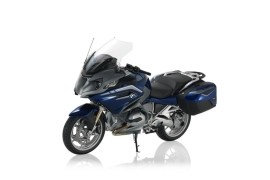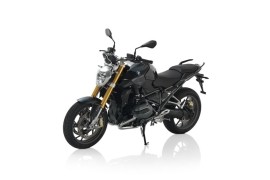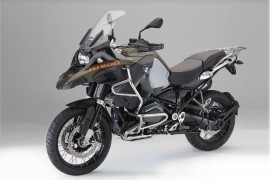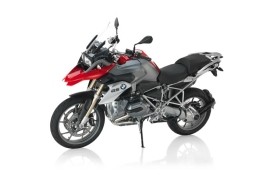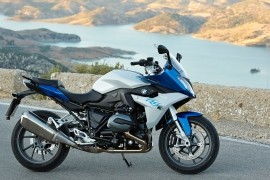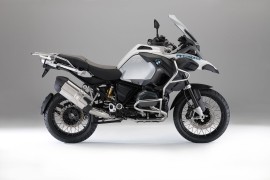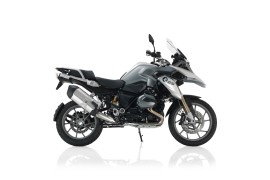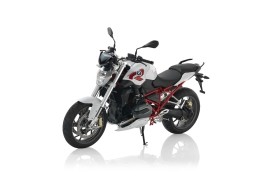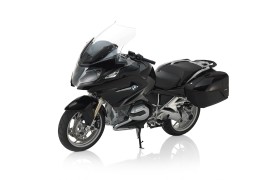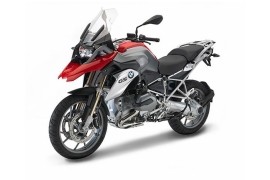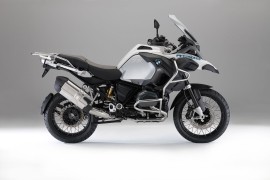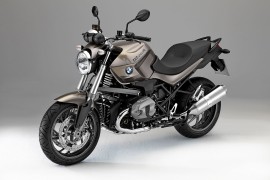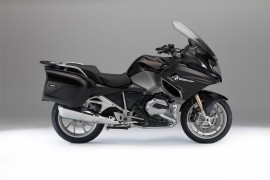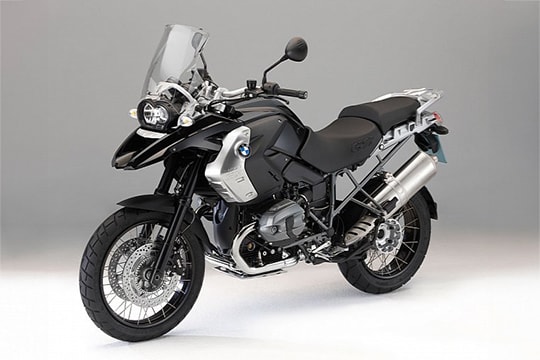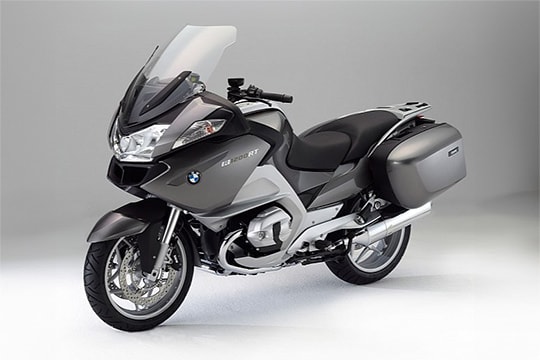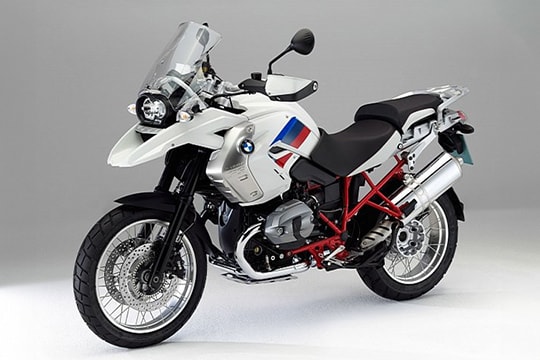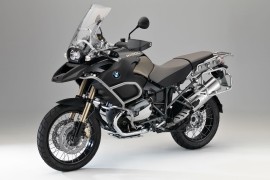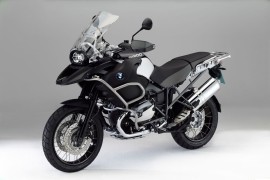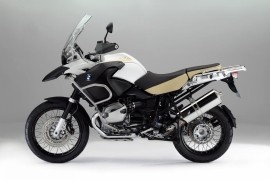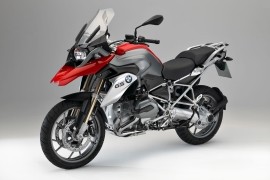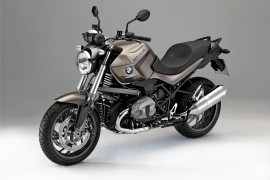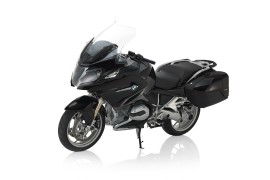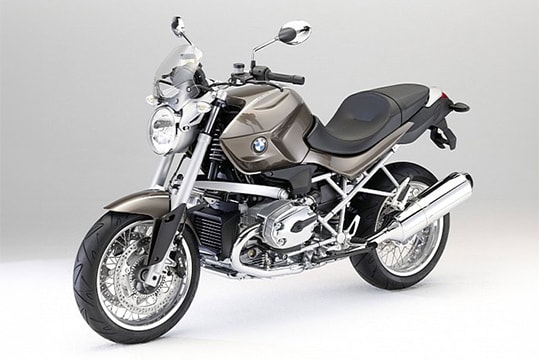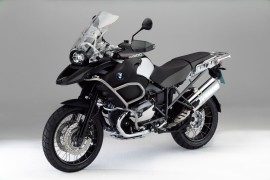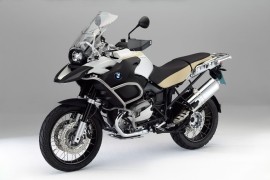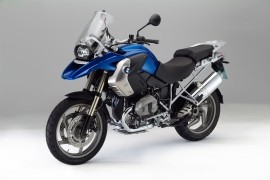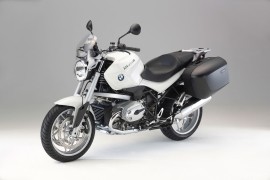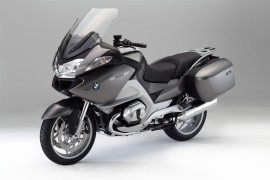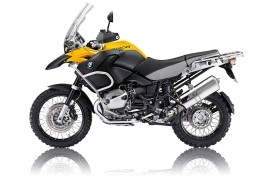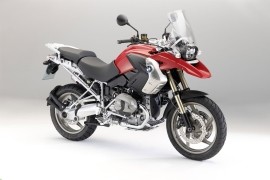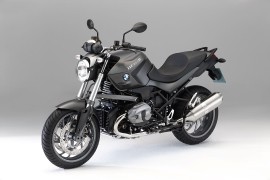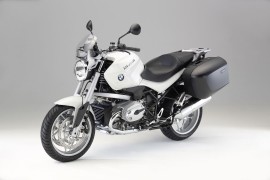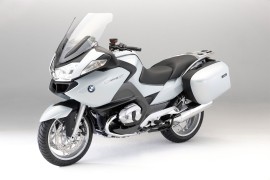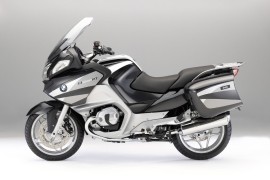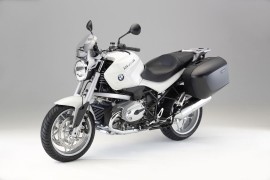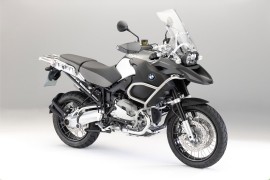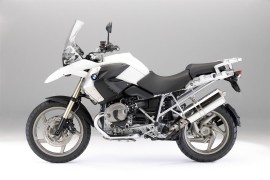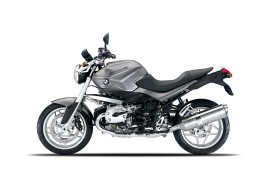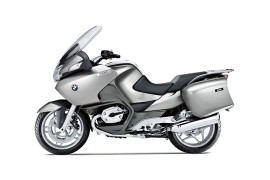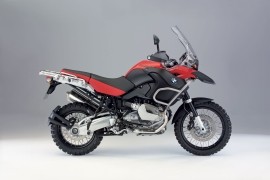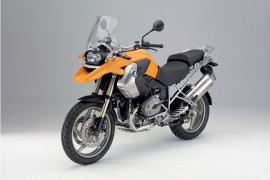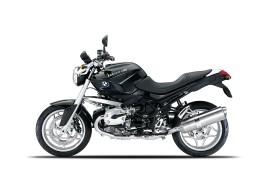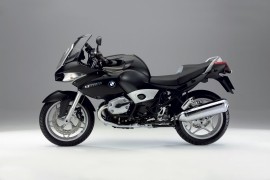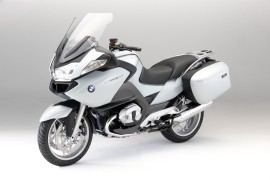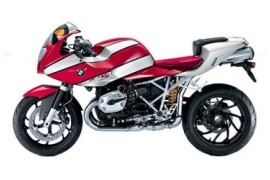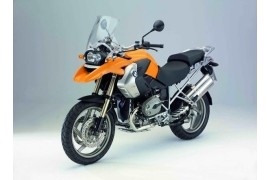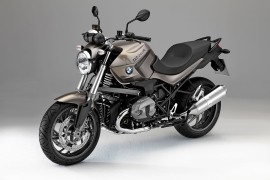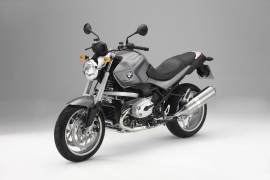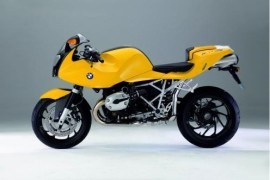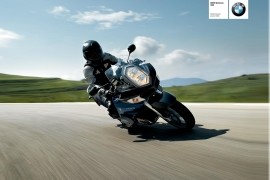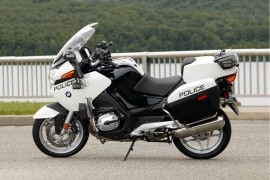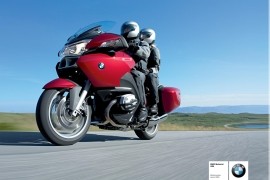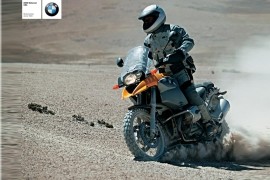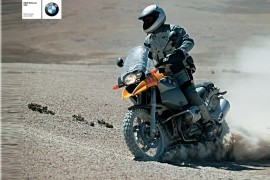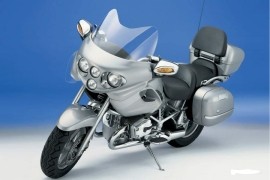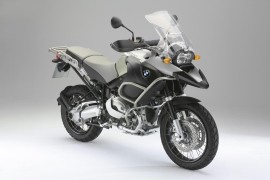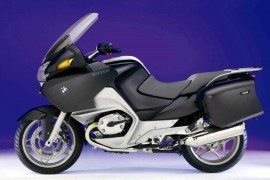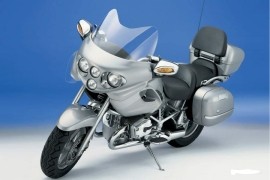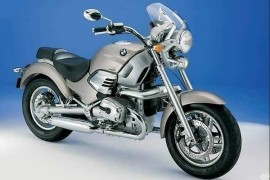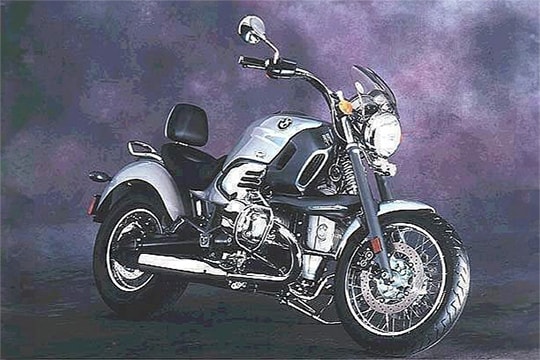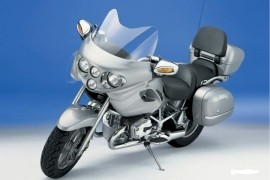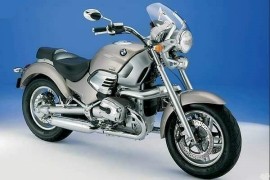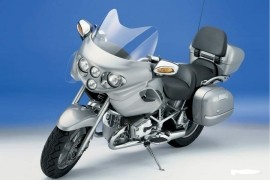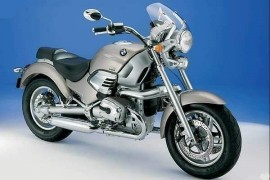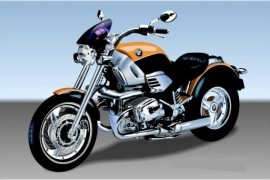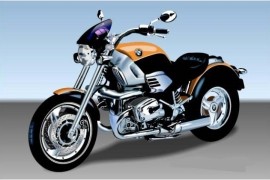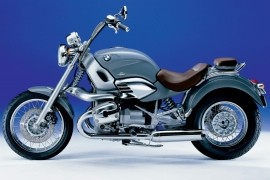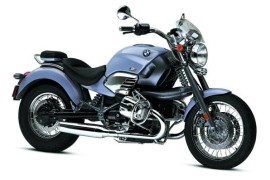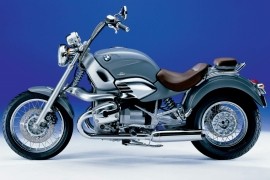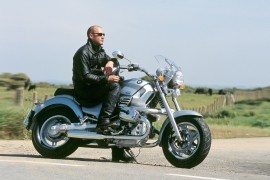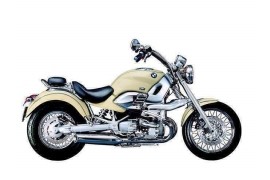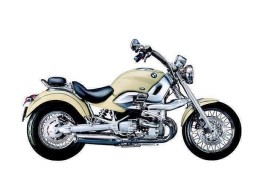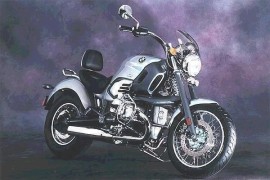BMW R 1200 Models/Series Timeline, Specifications & Photos
First production year: 1996
In 2015, the German motorcycle maker released the BMW R1200RT, the most touring-oriented motorcycle in the R1200 range. The bike had various accessories and technologies that improved comfort, safety, performance, and long-haul capabilities.
The BMW R1200RT was a sporty touring motorcycle created by BMW in 2005 to replace the BMW R1150RT. It continued production until 2019, when it was replaced by the BMW R1250RT.
The motorcycle's appearance was complemented by standard fittings, such as a full fairing, dual headlights, a large windscreen, a two-piece dual seat with passenger grab handles, a luggage rack, side-mounted panniers, a side stand, and ten-spoke alloy wheels.
The bike's suspension system comprised a 37 mm BMW Motorrad Telelever system on the front with 120 mm of travel and a cast-aluminum single-sided swingarm paired with a BMW EVO Paralever system with 136 mm of travel on the rear.
Two 320 mm discs coupled to four-piston calipers on the front and a 276 mm brake disc with a dual-piston caliper on the rear achieved the braking performance.
As for the power figures, the 2015 BMW R1200RT had its soul brought to life by a 1,170cc four-stroke air/liquid-cooled two-cylinder boxer engine fed by a fuel injection system, boasting 125 hp with maximum strength at 7,750 rpm and 125 Nm (92 lb-ft) torque at 6,000 rpm.
In 2015, the German motorcycle maker introduced the BMW R1200R, a standard motorcycle made by BMW in 2006 to replace the BMW R1150R. It was manufactured until 2018, when it was replaced by the R1250R.
The 2015 model was completely new, wearing the same boxer engine as the previous models and weighing 45 kg (100 lbs) less. It was a powerful naked roadster with the best technologies the House of Munich developed.
Visually, the bike had standard features, such as a single-headlight unit, a two-piece dual seat with pillion grab rails, a blacked-out engine, a two-into-one exhaust system, a single-sided swingarm, and ten-spoke alloy wheels.
The bike's suspension comprised a 45 mm inverted telescopic fork on the front with 140 mm of travel and an adjustable BMW Motorrad Paralever system on the rear with 140 mm of travel.
As for the braking power, the motorcycle had its wheels fitted with two 320 mm brake rotors and four-piston calipers on the front and a 275 mm brake disc with a dual-piston caliper on the rear.
In the performance department, the 2015 BMW R1200R had installed a 1,170cc four-stroke air/liquid-cooled twin-cylinder boxer engine underneath the fuel tank, boasting 125 hp with a peak force at 7,750 rpm and 125 Nm (92 lb-ft) torque at 6,500 rpm.
In 2015, the German motorcycle maker released the BMW R1200GS Adventure, a more adventurous version of the standard R1200GS that featured several touring-oriented accessories, which made it more suited for longer journeys.
The BMW R1200GS Adventure, also known as the R1200GSA, was an adventure motorcycle made by BMW from 2005 until 2013, when it was replaced by the BMW R1200GS Adventure (LC), which was made from 2014 to 2019.
The 2015 model came in the same shape and form as the previous one, packing the same technical, visual, and performance specifications without any significant modifications whatsoever.
In the aesthetic department, the motorcycle was equipped with standard fittings, like a front cowl with an extended beak, a single headlight unit, a small windscreen, a two-piece dual seat with pillion grab rails, a luggage rack, and wire-spoke wheels.
For suspension, the model packed a 41 mm adjustable Telelever system on the front that offered 210 mm of travel and a single-sided swingarm with an adjustable BMW Motorrad Paralever system on the rear that provided 220 mm of travel.
As for the power figures, the 2015 BMW R1200GS Adventure had its soul brought to life by a 1,170cc four-stroke air/liquid-cooled twin-cylinder boxer engine that delivered an output power of 125 hp with a peak force at 7,500 rpm and 125 Nm (92 lb-ft) torque at 5,500 rpm.
The BMW R1200GS was a dual-sports motorcycle created by BMW from 2004 until 2012 and 2013 until 2019. The bike was powered by a 1,170cc twin-cylinder boxer engine with four valves per cylinder.
In 2015, the German motorcycle manufacturer launched the BMW R1200GS, an air/liquid-cooled version of the previous 2004-2012 R1200GS. When first released in 2013, the bike was recalled in the UK due to malfunctions that covered the front brakes, ABS, throttle cable, fuel pump, clutch, final drive assembly, brake pipes, and transmission.
Visually, the bike was fitted with standard features, such as an aggressive front cowl with an extended beak, a small windscreen, a two-piece dual-seat with pillion grab rails, a luggage rack, a side stand, and ten-spoke alloy wheels.
As for the power figures, the 2015 BMW R1200GS boasted 125 hp at 7,750 rpm and 125 Nm (92 lb-ft) torque at 6,500 rpm, coming from a 1,170cc four-stroke air/liquid-cooled twin-cylinder boxer engine fed by an Electronic Fuel Injection (EFI) system.
All the power generated by the powerhouse was sent to a six-speed transmission controlled by an anti-hopping wet clutch that redirected it to the rear end via a final shaft drive, launching the motorcycle to a top speed of 215 kph (134 mph).
As for the stopping power, the motorcycle relied on two 305 mm rotors mounted on the front wheel and a single 265 mm rotor mounted on the rear wheel. The front discs were tied to four-piston calipers, and the rear one was handled by a two-piston caliper.
The BMW R1200RS was a sport-touring motorcycle created by BMW in 2015 to replace the BMW R1200ST. It was presented in September at the 2014 Intermot Motorcycle Show and was based on the BMW R1200R.
The all-rounder was powered by a boxer engine assembled at BMW's plant in Berlin, while the bike's production started on February nine, 2015, and was released into the market on May 12, 2015, at a base price of $14,600.
In 2015, the German motorcycle maker launched the BMW R1200RS, a sport-touring motorcycle that delivered the unmistakable sound and feel of a boxer engine. It was fitted with modern technology created by the House of Munich.
The bike's visual department was characterized by standard features, such as a half fairing with a dual headlight system, a windscreen, a two-piece dual seat with passenger grab rails, a two-into-one exhaust system, and ten-spoke alloy wheels.
For suspension, the bike packed a 45 mm upside-down telescopic fork on the front with 140 mm of travel and a single-sided cast aluminum swingarm with a BMW Motorrad Paralever system on the rear with 140 mm of travel.
In the power department, the 2015 BMW R1200RS had its heartbeat set by a 1,170cc four-stroke air/liquid-cooled two-cylinder boxer engine mounted underneath its fuel tank, boasting 125 hp at 7,750 rpm and 125 Nm (92 lb-ft) torque at 6,500 rpm.
The BMW R1200GS Adventure, also known as the R1200GSA, was an adventure motorcycle made by BMW from 2005 until 2013, when it was replaced by the BMW R1200GS Adventure (LC), which was made from 2014 to 2019.
In 2014, the German motorcycle manufacturer released the BMW R1200GS Adventure, a more touring-oriented version of the base model, fitted with touring-oriented accessories that enhanced its overall capabilities.
The 2014 Adventure model, as well as the base model, came with several improvements that included adjustments in the handling department and adding features, such as LED headlights, keyless ignition, a quick-shifter, an anti-theft system, and a lower seat option. In addition, the bike had an ABS mode available as a software update that allowed safer braking.
The motorcycle's aesthetic department was characterized by standard fittings, such as a half fairing with an extended beak, a tinted windscreen, a one-piece dual seat, pillion grab rails, a tank bag, a top box, panniers, a two-into-one exhaust system, and wire-spoke wheels.
For suspension, the model packed a 41 mm adjustable Telelever system on the front that offered 210 mm of travel and a single-sided swingarm with an adjustable BMW Motorrad Paralever system on the rear that provided 220 mm of travel.
Power-wise, the 2014 BMW R1200GS Adventure had its soul brought to life by a 1,170cc four-stroke air/liquid-cooled twin-cylinder boxer engine that delivered an output power of 125 hp at 7,500 rpm and 125 Nm (92 lb-ft) torque at 5,500 rpm.
In 2014, the German motorcycle maker released the BMW R1200GS, a motorcycle made by BMW in 2004. The 2014 model came with several technical modifications that enhanced its overall capabilities.
Some improvements included adjustments in the handling department and adding features, such as LED headlights, keyless ignition, a quick-shifter, an anti-theft system, and a lower seat option. In addition, the bike had an ABS mode available as a software update that allowed safer braking.
In the aesthetic department, the motorcycle packed standard fittings, such as a front cowl with an extended beak, a windscreen, a two-piece dual seat with passenger grab handles, a luggage rack, a two-into-one exhaust system, and ten-spoke alloy wheels.
The motorcycle's riding experience was softened by a 37 mm BMW Motorrad Telelever system on the front with 190 mm of travel and a single-sided aluminum swingarm coupled to a BMW Motorrad Paralever system on the rear with 220 mm of travel.
As for the braking power, the motorcycle's wheels were fitted with two 305 mm brake discs with four-piston calipers on the front and a single 265 mm brake disc with a dual-piston caliper on the rear.
As for power, the 2014 BMW R1200GS was set in motion by a 1,170cc four-stroke air/liquid-cooled twin-cylinder boxer engine that delivered an output power of 125 hp at 7,750 rpm and 125 Nm (92 lb-ft) torque at 6,500 rpm.
The BMW R1200R was a standard motorcycle made by BMW in 2006 as a replacement model for the R1150R. It was manufactured for over 12 years until 2018, when it was replaced by the BMW R1250R.
In 2014, the German motorcycle manufacturer released the BMW R1200R, a naked motorcycle powered by a 1,170cc twin-cylinder boxer engine assisted by a six-speed manual transmission and a shaft drive.
The bike's visual department was complemented by standard features, such as a round headlight upfront, a one-piece dual seat with passenger grab rails, a two-into-one exhaust system with a chromed silencer mounted on the left-hand side, and ten-spoke alloy wheels.
It was built around a tubular steel space frame that housed the suspension system comprised of a 41 mm BMW Motorrad Telelever system on the front that offered 120 mm of travel and a single-sided swingarm with a BMW Motorrad Paralever system on the rear that provided 140 mm of travel.
Two 320 mm brake rotors on the front and a 265 mm braking rotor on the rear achieved the braking power. The front ones were coupled to four-piston fixed calipers, and the rear one was tied to a dual-piston fixed calipers.
In the performance department, the 2014 BMW R1200R had its heartbeat set by a 1,170cc four-stroke air/oil-cooled twin-cylinder boxer engine that delivered an output power of 125 hp at 7,750 rpm and 125 Nm (92 lb-ft) torque at 6,500 rpm.
The BMW R1200RT was a sporty touring motorcycle manufactured by BMW from 2005 to 2019. It replaced the BMW R1150RT in 2005 and was replaced by the BMW R1250RT in 2019.
In 2014, the German motorcycle maker released the BMW R1200RT, a redesigned model that featured a conversion from an air/oil-cooled to a liquid-cooled engine. With their own testing technology, BMW claimed 125 hp and 125 Nm.
Some modifications included an updated seat position, fairing, instrumentation, and frame. The bike featured two standard riding modes, Rain and Road, that were activated at the press of a button, adapting to road and weather conditions.
The bike also featured an on-board computer, an electrically-operated windscreen, color-matched panniers, and heated grips, all basic equipment.
In addition, the motorcycle was available with optional equipment, such as semi-active Electronic Suspension Adjustment (ESA), BMW Dynamic ESA, a central locking system, a radio, a top case, a tank bag, cruise control, and low or high saddles.
The bike's visual department was complemented by standard fittings, such as a full fairing, a large windscreen, a pulled-back handlebar, a two-piece dual seat, a luggage rack, and 10-spoke alloy wheels.
As for power, the 2014 BMW R1200RT had its soul brought to life by a 1,170cc four-stroke liquid-cooled twin-cylinder boxer engine that delivered an output power of 125 hp at 7,750 rpm and 125 Nm (92 lb-ft) torque at 6,000 rpm.
The BMW R1200GS was a dual-sports motorcycle created by BMW from 2004 until 2012 and 2013 until 2019. The bike was powered by a 1,170cc twin-cylinder boxer engine with four valves per cylinder.
In 2013, the German motorcycle manufacturer released the BMW R1200GS, a motorcycle that had a shaky start. The bike was recalled in the UK due to malfunctions that covered the front brakes, ABS, throttle cable, fuel pump, clutch, final drive assembly, brake pipes, and transmission.
Visually, the motorcycle was complemented by standard features, such as a front cowl with a beak and a windscreen, a two-piece dual seat with passenger grab handles, a luggage rack, an engine skid plate, a two-into-one exhaust system, and 10-spoke alloy wheels.
The motorcycle's suspension system comprised a 37 mm BMW Motorrad Telelever system on the front with 190 mm of travel and a single-sided aluminum swingarm with a BMW Motorrad Paralever system on the rear with 220 mm of travel.
The 2013 BMW R1200GS had installed a 1,170cc four-stroke liquid-cooled twin-cylinder boxer engine that delivered an output power of 125 hp at 7,750 rpm and 125 Nm (92 lb-ft) torque at 6,500 rpm.
All the power generated by the engine was sent to the rear end through a six-speed transmission and a final shaft drive, pushing the motorcycle to a top speed of 215 kph (134 mph).
In 2013, the German motorcycle maker released the BMW R1200GS Adventure, the same machine as the R1200GS standard model but fitted with several touring-oriented features that enhanced its overall capabilities.
The BMW R1200GS Adventure, also known as the R1200GSA, was an adventure motorcycle made by BMW from 2005 until 2013, when it was replaced by the BMW R1200GS Adventure (LC), which was made from 2014 to 2019.
In addition to the standard's model features, the Adventure version featured a larger windscreen for better protection against elements, wire-spoke wheels for improved off-road capabilities, and a luggage rack that allowed the rider to take more stuff with him in his longer strolls.
The motorcycle's aesthetic department was complemented by standard features, like an adjustable windscreen, heated grips, hand guards, a two-piece dual seat with passenger grab handles, side-mounted aluminum panniers, a top box, and wire-spoke wheels with off-road tires.
As for suspension, the model packed a 41 mm adjustable Telelever system on the front that offered 210 mm of travel and a single-sided swingarm with an adjustable BMW Motorrad Paralever system on the rear that provided 220 mm of travel.
As for power, the 2013 BMW R1200GS Adventure had its heartbeat set by a 1,170cc four-stroke air/oil-cooled twin-cylinder boxer engine mounted at its core, delivering 110 hp at 7,750 rpm and 120 Nm (88 lb-ft) torque at 6,000 rpm.
In 2013, the German motorcycle manufacturer released the BMW R1200R, a standard motorcycle in BMW's range that debuted in 2006 as a replacement for the R1150R. It was manufactured until 2018, when it was replaced by the R1250R.
The 2013 model came in the same shape and form as the previous model. It remained mechanically unchanged but received new metallic paint finishes like Blue and Magnesium Beige.
The motorcycle's visual department was characterized by standard fittings, such as a round headlight with instruments mounted on top, a one-piece dual seat with passenger grab rails, a two-into-one exhaust system with a chromed silencer mounted on the left-hand side, and 10-spoke alloy wheels.
The motorcycle packed a BMW Motorrad Telelever suspension system on the front and a BMW Motorrad Paralelver on the rear, offering excellent suspension performance and handling capabilities.
As for the braking power, the motorcycle was handled by two 320 mm brake rotors on the front and a 265 mm brake rotor on the rear. The front ones were coupled to four-piston fixed calipers, and the rear one was tied to a dual-piston fixed calipers.
In the performance department, the 2013 BMW R1200R had its heartbeat set by a 1,170cc four-stroke air-oil-cooled two-cylinder boxer engine that delivered 109 hp at 7,500 rpm and 115 Nm (85 lb-ft) torque at 6,000 rpm.
The BMW R1200RT was a touring or sport touring motorcycle made by BMW in 2005 as a replacement model for the R1150RT and continued production until 2019, when it was replaced by the BMW R1250RT.
Compared to its predecessor, R1150RT, the R1200RT was completely different, with a 15 percent increase in power and a 20 kg (44 lbs) weight reduction. It was also available with an optional Electronic Suspension Adjustment (ESA) system and an on-board computer.
In 2013, the German motorcycle manufacturer released the BMW R1200RT, a sporty touring motorcycle with the unmistakable feel and sound of a boxer engine. It came with the same settings as the previous one without significant modifications.
The motorcycle's appearance was characterized by standard features, such as a full fairing, a single headlight unit, a tall windscreen, integrated turn signals, a two-piece dual seat with passenger grab rails, a luggage rack, side-mounted panniers, and alloy wheels.
For suspension, the motorcycle packed a 35 mm BMW Motorrad Telelever system on the front with 120 mm of travel and a single-sided aluminum swingarm with a BMW Motorrad EVO-Paralever system on the rear with 135 mm of travel.
As for power, the 2013 BMW R1200RT was set in motion by a 1,170cc four-stroke air/oil-cooled twin-cylinder engine mounted underneath its fuel tank, delivering an output power of 110 hp at 7,750 rpm and 121 Nm (89 lb-ft) torque at 6,000 rpm.
The BMW R1200GS, alongside the R1200GS Adventure (also known as the R1200GSA), was a motorcycle produced by BMW Motorrad in Berlin, Germany, from 2004 to 2012. The BMW R1200GS Adventure was manufactured from 2005 until 2013.
In 2012, the German motorcycle manufacturer released the BMW R1200GS Triple Black, a motorcycle in its second production year. The bike packed the same specifications as the previous model without modifications.
The engineers from the House of Munich took the base R1200GS model and made it mode dark. It came with the Sapphire Black Metallic body paint, wire-spoke wheels with blacked-out rims, a black front fork, black engine accents, an embossed seat with a GS logo, an Asphalt Grey Metallic swingarm, rear frame, and valve covers.
In the tech department, the bike was similar to the base model, except for the Premium Package Equipment, which included the Electronic Suspension Adjustment (ESA) system, heated grips, an on-board computer, hand guards, integral ABS, and saddle bag mounts.
As for power, the 2012 BMW R1200GS Triple Black had its soul brought to life by a 1,170cc four-stroke twin-cylinder air/oil-cooled boxer engine that delivered 110 hp at 7,750 rpm and 121 Nm (89 lb-ft) torque at 6,000 rpm.
Braking-wise, the motorcycle packed two 305 mm brake rotors with four-piston fixed calipers on the front and a 265 mm disc with a two-piston caliper on the rear.
The BMW R1200RT was a touring or sport touring motorcycle created by BMW in 2005 as a replacement for the R1150RT and continued production until 2019, when it was replaced by the BMW R1250RT.
In 2012, the German motorcycle manufacturer launched the BMW R1200RT Special Equipment Package. The special edition machine featured many popular optional features as standard.
The bike had standard features, such as a full fairing, a tall windscreen, a pulled-back handlebar, a two-piece dual seat with passenger grab handles, a luggage rack, panniers, and aluminum alloy wheels.
In addition to its standard features, the bike came with multiple optional features, like a chrome exhaust system, heated seat, heated grips, an additional power socket, and an on-board computer with oil level warning.
As for its technical department, the motorcycle packed an Electronic Suspension Adjustment 2 (ESA 2), BMW Motorrad Integral ABS (partial), BMW Motorrad Telelver and Paralever suspensions, Cruise Control, one key for ignition, steering, fuel filler cap, seat, and helmet locks.
As for power, the 2012 BMW R1200RT Special Equipment Package had its soul brought to life by a 1,170cc four-stroke air/oil-cooled twin-cylinder engine that delivered 110 hp at 7,750 rpm and 121 Nm (89 lb-ft) torque at 6,000 rpm.
The front end was handled by a Telelever system and two 305 mm discs, while the rear end was controlled by a Paralever system and a 265 mm brake disc.
In 2012, alongside the standard model, the German motorcycle manufacturer released the BMW R1200GS Rallye, a special motorcycle created for the more adventurous among BMW fans.
Visually, the bike had standard features, such as a half fairing, a windscreen, hand guards, a two-piece dual seat with passenger grab rails, a luggage rack, a two-into-one exhaust system, and five-spoke aluminum wheels.
In addition to its standard features, the Rallye version had Alpine White-painted body parts, BMW Motorrad Motorsports graphic colors, black-finished fork sliders, black engine, Magma red-finished rear frame, Asphalt Grey Metallic swingarm, Granite Grey Metallic cylinder head covers, and a black and white seat.
Also, the motorcycle came with an Electronic Suspension Adjustment (ESA) system, a chromed exhaust system, wire-spoke wheels, heated grips, white hand protectors, pannier holders, and an on-board computer.
It was built around a tubular steel frame with a 41 mm Telelever system on the front and a single-sided aluminum swingarm with a Paralever system on the rear, providing excellent suspension performance and handling capabilities.
The braking performance was handled by two 305 mm rotors and four-piston calipers on the front wheel and a 265 mm rotor with a dual-piston caliper on the rear wheel.
As for the power figures, the 2012 BMW R1200GS Rallye had installed a 1,170cc four-stroke air/oil-cooled two-cylinder boxer engine at its core, boasting 110 hp at 7,750 rpm and 121 Nm (89 lb-ft) torque at 6,000 rpm.
In 2012, the German motorcycle manufacturer introduced the BMW R1200GS Adventure 90th Anniversary, which included the R1200GS Adventure, R1200RT, and R1200R. The Anniversary model remained mechanically unchanged and received an exclusive paint job that differentiated from the base model.
All anniversary models came in a Sapphire Black Metallic color scheme with black engines, gold anodized suspension and brakes, an Asphalt Grey Metallic swingarm, and Granite Gray Metallic cylinder head covers.
Visually, the motorcycle had standard features, such as a single headlight unit, a tall windscreen, a two-piece dual seat with passenger grab rails, a luggage rack, a two-into-one exhaust system, a single-sided swingarm, and wire-spoke wheels.
Suspension-wise, the motorcycle packed a 41 mm BMW Motorrad Telelever system on the front with 210 mm of travel and a single-sided aluminum swingarm with a BMW Motorrad Paralever system on the rear.
As for the braking power, the motorcycle's wheels were equipped with two 305 mm discs and four-piston calipers on the front and a 265 mm rotor with a dual-piston caliper on the rear. As an option, the motorcycle was available with BMW Motorrad Integral ABS.
As for power, the 2012 BMW R1200GS Adventure 90 Years Special Model had installed a 1,170cc four-stroke air/oil-cooled twin-cylinder boxer engine that delivered 110 hp with a peak force at 7,750 rpm and 120 Nm (88 lb-ft) torque at 6,000 rpm.
The first motorcycle in the Triple Black range was the R1200GS, launched in 2010 and proved very popular. The Triple Black series offered a black appearance and aggressive styling.
In 2012, the German motorcycle manufacturer introduced the BMW R1200GS Adventure Triple Black, a bike created for the more adventurous ones among BMW fans. It packed additional touring elements that enhanced its overall capabilities.
Compared to the R1200GS Triple Black, the Adventure Triple Black had a 33-liter fuel tank, a taller windscreen, wire-spoke wheels, longer travel suspension, and rugged engine protection bars.
Aesthetically, the motorcycle packed standard fittings, such as a single headlight unit, a tall windscreen, hand guards, engine bars, a two-piece dual seat with passenger grab rails, a luggage rack, a two-into-one exhaust system, a single-sided swingarm, and wire-spoke wheels with blacked-out rims.
The engineers from the House of Munich used three shades of black and gray, giving it an unmistakable modern appearance.
The 2012 BMW R1200GS Adventure Triple Black had its soul brought to life by a 1,170cc four-stroke air/oil-cooled twin-cylinder boxer engine that delivered an output power of 110 hp at 7,750 rpm and 120 Nm (88 lb-ft) torque at 6,000 rpm.
The power generated by the engine was sent to the rear axle via a six-speed transmission and a final shaft drive, pushing the motorcycle to a top speed of 193 kph (120 mph).
The BMW R1200GS Adventure, also known as the R1200GSA, was an adventure motorcycle manufactured by BMW from 2005 until 2013 when it was replaced by the BMW R1200GS Adventure (LC), which was made from 2014 to 2019.
In 2012, the German motorcycle manufacturer released the BMW R1200GS Adventure, basically a base model fitted with touring-oriented features and accessories that enhanced its overall capabilities.
Compared to the base model, the Adventure version featured a larger windscreen for better protection against elements, wire-spoke wheels for improved off-road capabilities, and a luggage rack that allowed the rider to take more stuff with him in his longer strolls.
Suspension-wise, the motorcycle featured a 41 mm adjustable Telelever system on the front that offered 210 mm of travel and a single-sided swingarm with an adjustable BMW Motorrad Paralever system on the rear that provided 220 mm of travel.
In the performance department, the 2012 BMW R1200GS Adventure had installed a 1,170cc four-stroke air/oil-cooled twin-cylinder boxer engine mounted underneath its fuel tank, boasting 110 hp at 7,750 rpm and 120 Nm (88 lb-ft) torque at 6,000 rpm.
As for its standard features, the motorcycle packed an adjustable windscreen, heated grips, hand guards, a two-piece dual seat with passenger grab handles, side-mounted aluminum panniers, a top box, and wire-spoke wheels with off-road tires.
In 2012, the German motorcycle manufacturer released the BMW R1200GS, an adventure model that debuted in 2004. In addition, the standard model was also available with an adventure package under the R1200GS Adventure designation.
It came with the same package as the previous model, packing the same technical, visual, and performance specifications without any significant modifications whatsoever.
In the visual department, the bike had standard fittings, such as a single headlight unit, a small windscreen, a two-piece dual seat with passenger grab rails, a luggage rack, a two-into-one exhaust system with a silencer mounted on the left-hand side, and five-spoke alloy wheels.
Suspension-wise, the motorcycle packed a 41 mm BMW Motorrad Telelever suspension system on the front with 190 mm of travel and a BMW Motorrad Paralever system on the rear with 200 mm of travel.
As for the braking power, the motorcycle's wheels were fitted with two 305 mm brake discs on the front and a 265 mm brake disc on the rear. The front ones were handled by four-piston calipers, and the rear one was managed by a dual-piston caliper. In addition, it was available with optional BMW Motorrad Integral ABS.
The 2012 BMW R1200GS had its soul brought to life by a 1,170cc four-stroke air/oil-cooled twin-cylinder boxer engine that delivered an output power of 110 hp at 7,750 rpm and 120 Nm (88 lb-ft) torque at 6,000 rpm.
First introduced in 2006, the BMW R1200R was a standard motorcycle that replaced the BMW R1150R and continued production until 2018, when it was replaced by the BMW R1250R. Compared to the R1150R predecessor, the R1200R had 28 percent more power and was 25 kg (55 lbs) lighter.
In 2012, the German motorcycle manufacturer released the BMW R1200R, a standard machine in its seventh production year. It came in the same shape and form as the previous one without any modifications whatsoever.
The bike's aesthetic department was characterized by standard features, such as a round headlight with instruments mounted on top, a one-piece dual seat with passenger grab rails, a two-into-one exhaust system with a chromed silencer mounted on the left-hand side, and 10-spoke alloy wheels.
The bike's wheels had two 320 mm discs on the front and a 265 mm disc on the rear. The front ones were coupled to four-piston fixed calipers, and the rear one was tied to a dual-piston fixed calipers.
It was built around an aluminum and steel frame with a BMW Motorrad Telelever suspension system on the front and a BMW Motorrad Paralelver on the rear, offering excellent suspension performance and handling.
As for the power figures, the 2012 BMW R1200R had installed a 1,170cc four-stroke air/oil-cooled twin-cylinder boxer engine that delivered an output power of 109 hp at 7,500 rpm and 115 Nm (85 lb-ft) torque at 6,000 rpm.
In 2012, the German motorcycle maker released the BMW R1200RT, a touring machine that debuted in 2005 as a replacement model for the BMW R1150RT and ended production in 2019 when it was replaced by the BMW R1250RT.
Compared to its predecessor, R1150RT, the R1200RT was completely different, with a 15 percent increase in power and a 20 kg (44 lbs) weight reduction. It was also available with an optional Electronic Suspension Adjustment (ESA) system and an on-board computer.
Visually, the bike had standard fittings, such as a full fairing, a large headlight unit, integrated turn signals, a tall windscreen, a two-piece dual seat, a luggage rack, panniers, a two-into-one exhaust system, and aluminum alloy wheels.
Suspension-wise, the motorcycle packed a 35 mm BMW Motorrad Telelever system on the front with 120 mm of travel and a single-sided aluminum swingarm with a BMW Motorrad EVO-Paralever system on the rear with 135 mm of travel.
Two 320 mm discs mounted on the front wheel and a 265 mm disc mounted on the rear wheel achieved the braking power. The front was coupled to four-piston calipers, and the rear with a dual-piston caliper.
The 2012 BMW R1200RT had installed a 1,170cc four-stroke air/oil-cooled twin-cylinder engine underneath its fuel tank, delivering an output power of 110 hp at 7,750 rpm and 121 Nm (89 lb-ft) torque at 6,000 rpm.
The BMW R1200R was a standard motorcycle manufactured by BMW in 2006 as a replacement for the BMW R1150R, continuing production until 2018. The bike was eventually replaced by the BMW R1250R.
In 2011, the German motorcycle manufacturer launched the BMW R1200R Classic, a motorcycle created for the more nostalgic riders among BMW fans. It packed the same engine, transmission, and chassis as the base model and was fitted with several classic elements.
It also boasted the latest technologies developed by German engineers complemented by classic elements, such as wire-spoke wheels with polished rims and a chrome-plated stainless steel two-into-one exhaust system.
Aesthetically, the bike had standard fittings, like a round headlight, a small windscreen, a one-piece dual seat, an engine plate, a single exhaust system with a silencer mounted on the left-hand side, and wire-spoke wheels.
For suspension, the motorcycle packed a 41 mm BMW Motorrad Telelever system on the front with 120 mm of travel and a BMW Motorrad Paralever system on the rear with 140 mm of travel.
Braking-wise, the bike relied on two 320 mm floating discs with four-piston fixed calipers on the front and a 265 mm fixed disc with a two-piston fixed caliper on the rear.
As for power, the 2010 BMW R1200R Classic had its soul brought to life by a 1,170cc four-stroke twin-cylinder air/oil-cooled boxer engine that offered 109 hp at 7,500 rpm and 115 Nm (85 lb-ft) torque at 6,000 rpm.
In 2011, the German motorcycle manufacturer introduced the BMW R1200GS Triple Black, a motorcycle created for those riders who wanted a darker and more aggressive-looking machine.
Compared to the standard model, the BMW R1200GS Triple Black packed a Sapphire Black Metallic body paint, wire-spoke wheels with blacked-out rims, a black front fork, black engine accents, an embossed seat with a GS logo, an Asphalt Grey Metallic swingarm, rear frame, and valve covers.
Tech-wise, the bike was similar to the base model, except for the Premium Package Equipment, which included the Electronic Suspension Adjustment (ESA) system, heated grips, an on-board computer, hand guards, integral ABS, and saddle bag mounts.
In the aesthetic department, the motorcycle packed a half fairing with a single headlight, a tall windscreen, hand guards, crash bars, a two-piece dual seat with passenger grab rails, a luggage rack, a two-into-one exhaust system with a chromed muffler mounted on the left-hand side, and wire-spoke wheels.
In the performance department, the 2011 BMW R1200GS Triple Black had its soul brought to life by a 1,170cc four-stroke air/oil-cooled twin-cylinder boxer engine managed by a fuel injection system. The engine boasted 110 hp at 6,000 rpm and 121 Nm (89 lb-ft) torque at 6,000 rpm.
As for the stopping power, the bike's wheels were fitted with two 305 mm brake rotors with four-piston fixed calipers on the front and a 265 mm disc with a two-piston caliper on the rear.
The BMW R1200GS Adventure, also known as the R1200GSA, was a motorcycle manufactured by BMW from 2005 until 2013 when it was replaced by the BMW R1200GS Adventure (LC) made from 2014 to 2019.
Unlike the standard model, the Adventure version packed a larger windscreen for better protection against elements, wire-spoke wheels for improved off-road capabilities, and a luggage rack that allowed the rider to take more stuff with him in his longer strolls.
In 2011, the German motorcycle maker released the BMW R1200GS Adventure. It was a standard machine fitted with a larger windscreen for better protection against elements, wire-spoke wheels for improved off-road capabilities, and a luggage rack that allowed the rider to take more stuff with him in his longer strolls.
The 2011 Adventure model had standard features, such as an adjustable windscreen, heated grips, hand guards, a two-piece dual seat with passenger grab handles, side-mounted aluminum panniers, a top box, and wire-spoke wheels with off-road tires.
The 2011 model came with the same package as the previous one, which received several modifications, such as a revised cylinder head with a double overhead camshaft (DOHC), an increased redline limit to 8,500 rpm, an increased power output to 110 hp, and an exhaust flap for a different sound.
As for the power figures, the 2011 BMW R1200GS Adventure had installed a 1,170cc four-stroke air/oil-cooled twin-cylinder boxer engine, boasting 110 hp at 7,500 rpm and 121 Nm (89 lb-ft) torque at 5,500 rpm.
The BMW R1200GS, alongside the R1200GS Adventure (also known as the R1200GSA), was a motorcycle made by BMW Motorrad in Berlin, Germany, from 2004 to 2012. The BMW R1200GS Adventure was manufactured from 2005 until 2013.
In 2011, the German motorcycle manufacturer released the BMW R1200GS, a motorcycle with the same package as the previous one, without any significant modifications.
Aesthetically, the bike had standard features, such as a half fairing, a windscreen, hand guards, a two-piece dual seat with passenger grab rails, a luggage rack, a two-into-one exhaust system, and five-spoke aluminum wheels.
For suspension, the bike packed a 41 mm adjustable Telelever system on the front with 190 mm of travel and a single-sided swingarm with an adjustable Paralever system on the rear that offered 200 mm of travel.
The braking power was achieved by two 305 mm brake rotors on the front coupled to four-piston fixed calipers and a 265 mm disc with a dual-piston caliper on the rear, offering optimum stopping power.
In the performance department, the 2011 BMW R1200GS had its soul brought to life by a 1,170cc four-stroke air/oil-cooled twin-cylinder engine mounted underneath its fuel tank, delivering 110 hp at 7,750 rpm and 121 Nm (89 lb-ft) torque at 6,000 rpm.
The power generated by the engine was transmitted to a six-speed manual transmission and sent to the rear wheel via a final shaft drive, pushing the motorcycle to a top speed of 207 kph (129 mph).
The BMW R1200R was a standard motorcycle introduced by BMW in 2006 as a replacement for the BMW R1150R, continuing production until 2018. The bike was eventually replaced by the BMW R1250R.
In 2011, the German motorcycle manufacturer launched the BMW R1200R, a standard machine in its sixth consecutive production year. It came in the same shape and form as the previous one without significant modifications.
Visually, the motorcycle packed standard features, such as a round headlight, a small windscreen, a one-piece dual seat, a luggage rack, a two-into-one exhaust system, and aluminum alloy wheels.
As for technology, the 2011 R1200R packed a closed three-way Catalytic Converter, an Anti-Theft Alarm System, Tire Pressure Control, Automatic Stability Control, ABS brakes, and Electronic Suspension Adjustment.
The 2011 BMW R1200R had its soul brought to life by a 1,170cc four-stroke twin-cylinder air/oil-cooled engine mounted underneath its fuel tank, delivering 109 hp at 7,500 rpm and 115 Nm (85 lb-ft) torque at 6,000 rpm.
The bike's riding experience was softened by a 41 mm BMW Motorrad Telelever suspension system on the front that provided 120 mm of travel and a single-sided aluminum swingarm with an adjustable BMW Motorrad Paralever system on the rear that offered 140 mm of travel.
As for the braking power, the motorcycle's wheels were fitted with two 320 mm floating discs tied to four-piston fixed calipers on the front and a 265 mm fixed disc with a two-piston fixed caliper.
The BMW R1200RT was a touring or sport touring motorcycle made by BMW in 2005 as a replacement model for the R1150RT and continued production until 2019, when it was replaced by the BMW R1250RT.
In 2011, the German motorcycle manufacturer launched the BMW R1200RT, a touring motorcycle in its seventh consecutive production year. It came with the same package as the previous one without any modifications.
The last revision was made in 2010. The most notable modification was the boxer engine, which incorporated the DOHC cylinder heads borrowed from the HP2 Sport model, which improved its power delivery and offered better engine performance.
In the visual department, the bike was fitted with standard features, such as full fairing with a tall windscreen, a pulled-back handlebar, a two-piece dual seat with passenger grab rails, a luggage rack, side-mounted panniers, a two-into-one exhaust system, and aluminum alloy wheels.
As for power, the 2010 BMW R1200RT had installed a 1,170cc four-stroke twin-cylinder air/oil-cooled boxer engine underneath its fuel tank, delivering an output power of 110 hp with maximum strength at 7,750 rpm and 120 Nm (89 lb-ft) torque at 6,000 rpm.
The power generated by the engine was transferred to a six-speed transmission and sent to the rear end via a final shaft drive, launching the motorcycle to a top speed of 210 kph (131 mph).
The R1200GS Adventure (also known as the R1200GSA), alongside the standard R1200GS, was an adventure machine created by BMW Motorrad in Berlin, Germany, in 2005 and manufactured until 2013.
In 2010, alongside the standard model, the German motorcycle manufacturer launched the BMW R1200GS Adventure 30th Anniversary Special, a special edition version of the Adventure model with several differences.
Some of the differences were represented by the white color with the BMW Motorrad Motorsport three-color stripe, 30 years decals on the fuel tank, wire-spoke wheels with black rims, extra-large hand guards, engine crash bars, and a red seat with an embossed GS stamp.
The bike had standard features, such as a half fairing, a tall windscreen, hand guards, a two-piece dual seat with passenger grab rails, a luggage rack, a two-into-one exhaust system, an engine plate, and wire-spoke wheels.
In the performance department, the 2010 BMW R1200GS Adventure 30th Anniversary Special had its heartbeat set by a 1,170cc four-stroke air/oil-cooled twin-cylinder boxer engine that delivered 110 hp at 7,500 rpm and 121 Nm (89 lb-ft) torque at 5,500 rpm.
The power generated by the engine was sent to the rear end through a six-speed transmission and a final shaft drive that pushed the motorcycle to a top speed of 193 kph (120 mph).
In 2010, the German motorcycle maker released the BMW R1200GS Adventure. It was a standard model with more touring-oriented accessories, enhancing its overall touring capabilities.
The R1200GS Adventure (also known as the R1200GSA), alongside the standard R1200GS, was an adventure motorcycle created by BMW Motorrad in Berlin, Germany, in 2005 and manufactured until 2013.
Unlike the base model, the Adventure version packed a larger windscreen for better protection against elements, wire-spoke wheels for improved off-road capabilities, and a luggage rack that allowed the rider to take more stuff with him in his longer strolls.
The 2010 Adventure model packed standard features such as an adjustable windscreen, heated hand grips, hand guards, a two-piece dual seat with passenger grab handles, side-mounted aluminum panniers, a top box, and wire-spoke wheels with off-road tires.
For suspension, the motorcycle packed a 41 mm adjustable Telelever system on the front that offered 210 mm of travel and a single-sided swingarm with an adjustable BMW Motorrad Paralever system on the rear that provided 220 mm of travel.
The 2010 Adventure model, like the standard version, received several modifications, like a revised cylinder head with a double overhead camshaft (DOHC), an increased redline limit to 8,500 rpm, an increased power output to 110 hp, and an exhaust flap for a different sound.
As for power, the 2010 BMW R1200GS Adventure had its heartbeat set by a 1,170cc four-stroke air/oil-cooled twin-cylinder boxer engine that boasted 110 hp at 7,500 rpm and 121 Nm (89 lb-ft) torque at 5,500 rpm.
The BMW R1200GS, alongside the R1200GS Adventure (also known as the R1200GSA), was a motorcycle made by BMW Motorrad in Berlin, Germany, from 2004 to 2012. The BMW R1200GS Adventure was manufactured from 2005 until 2013.
The standard motorcycle debuted in 2004 and ended production in 2012 when it was replaced by the R1200 GS (LC), while the adventure version was made in 2005 and was replaced by the R1200GS Adventure (LC) in 2014.
In 2010, the German motorcycle maker released the BMW R1200GS, a motorcycle in its eighth consecutive production year that featured several modifications.
The 2010 model received a revised cylinder head with a double overhead camshaft (DOHC), an increased redline limit to 8,500 rpm, an increased power output to 110 hp, and an exhaust flap for a different sound.
In the aesthetic department, the motorcycle was fitted with standard features, such as a half fairing, a windscreen, hand guards, a two-piece dual seat with passenger grab rails, a luggage rack, a two-into-one exhaust system, and five-spoke aluminum wheels.
For suspension, the bike packed a 41 mm adjustable Telelever system on the front with 190 mm of travel and a single-sided swingarm with an adjustable Paralever system on the rear that offered 200 mm of travel.
As for power, the 2010 BMW R1200GS took its muscles from a 1,170cc four-stroke twin-cylinder air/oil-cooled fuel-injected boxer engine that delivered 105 hp a 7,500 rpm and 115 Nm (85 lb-ft) torque at 5,750 rpm.
In 2010, the German motorcycle manufacturer released the BMW R1200R, a standard motorcycle that debuted in 2006 to replace the BMW R1150R. It was produced until 2018, when the BMW R1250R replaced it.
The bike's visual department was characterized by standard features, such as a round headlight upfront, no fairings whatsoever, a one-piece dual seat, a two-into-one exhaust system, and five double-spoke aluminum wheels.
For 2010, the maker also released a Touring Special edition, fitted with touring accessories like a luggage rack and brackets, a sports windscreen, a chromed exhaust system, panniers, an on-board computer, white turn signals, and a comfort seat.
Regarding technology, the 2010 R1200R packed a closed three-way Catalytic Converter, an Anti-Theft Alarm System, Tire Pressure Control, Automatic Stability Control, ABS brakes, and Electronic Suspension Adjustment.
It was made around a tubular steel frame with a 41 mm BMW Motorrad Telelever suspension system on the front that provided 120 mm of travel and a single-sided aluminum swingarm with an adjustable BMW Motorrad Paralever system on the rear that offered 140 mm of travel.
In the performance department, the 2010 BMW R1200R had its heartbeat set by a 1,170cc four-stroke twin-cylinder air/oil-cooled boxer engine, boasting 109 hp at 7,500 rpm and 115 Nm (85 lb-ft) torque at 6,000 rpm.
The BMW R1200R was a standard bike introduced by the German motorcycle maker in 2006 to replace the R1150R. The 2006 model was 25 kg (55 lbs) lighter than its predecessor and delivered 28 percent more power. It continued production until 2018, when it was replaced by the R1250R model.
In 2010, the German motorcycle manufacturer released the BMW R1200R Touring Special, a standard model fitted with several touring accessories. It combined the comfort of a tourer with the raw performance and extreme agility of a big-bore naked bike.
It came equipped with standard fittings, like a sports windscreen, a comfortable dual seat, a luggage rack, an on-board computer, a chromed exhaust system, a round headlight, side-mounted panniers, and aluminum alloy wheels.
A Telelever suspension system handled the bike's front suspension, and two 320 mm floating rotors with four-piston fixed calipers stopped the front wheel. In contrast, the rear end was controlled by a Paralever system and a 265 mm fixed disc with a two-piston fixed caliper.
The 2010 BMW R1200R Touring Special took its muscles from a 1,170cc four-stroke air/oil-cooled twin-cylinder boxer engine that delivered 109 hp with a peak force at 7,500 rpm and 115 Nm (85 lb-ft) torque at 6,000 rpm.
A six-speed manual transmission with a dry single-plate clutch redirected the power generated by the engine to the rear wheel via a shaft drive that pushed the motorcycle to a top speed of 220 kph (136 mph).
The BMW R1200RT was a touring but also sport-touring motorcycle made by BMW in 2005 to replace the R1150RT. It was manufactured for over 14 years until 2019, when it was succeeded by the R1250RT.
In 2010, the German motorcycle maker released the BMW R1200RT, a touring machine that debuted in 2005. The maker introduced several changes for the 2010 model year that improved its overall capabilities.
One of the most significant changes in the 2010 model was the boxer engine, which incorporated the DOHC cylinder heads borrowed from the HP2 Sport model, which improved its power delivery and offered better engine performance.
Although the power remained the same at 110 hp, torque increased from 115 to 120 Nm (85-89 lb-ft) at 6,000 rpm. Due to a new exhaust valve, the engine's power was spread over a wider range, making the motorcycle more usable.
Other improvements included a new fairing design with better wind and weather protection, new control units, a hydraulic reservoir, a new audio system with USB, MP3, and iPod connectivity, and new colors.
As for the power figures, the 2010 BMW R1200RT had installed a 1,170cc four-stroke twin-cylinder air/oil-cooled boxer engine underneath its fairing, delivering an output power of 110 hp with maximum strength at 7,750 rpm and 120 Nm (89 lb-ft) torque at 6,000 rpm.
In 2009, the German motorcycle manufacturer launched the BMW R1200RT, the most touring-oriented model in BMW's R1200 range. It was in its fifth consecutive production year and came in the same shape and form as the previous model without significant modifications.
The BMW R1200RT was a touring but also sport-touring motorcycle made by BMW in 2005 to replace the R1150RT. It was manufactured for over 14 years until 2019, when it was succeeded by the R1250RT.
Visually, the touring machine came fitted with standard features, such as a full fairing, a two-piece dual seat with passenger grab rails, a luggage rack, side-mounted panniers, a two-into-one exhaust system, and aluminum alloy wheels.
Additional features included hazard warning flashers, single key locks, a closed-loop three-way catalytic converter, adjustable clutch and brake levers, an adjustable rider seat, a diagnostic interface, an electronic immobilizer, an info flat screen, and a power socket.
The motorcycle was made around a steel and aluminum frame. It had a Telelever suspension system on the front end and a Paralever system on the rear, offering a plush riding experience.
As for power, the 2009 BMW R1200RT had installed a 1,170cc four-stroke air/oil-cooled boxer engine at its core, boasting 110 hp with a peak force at 7,750 rpm and 119 Nm (88 lb-ft) torque at 6,000 rpm.
The BMW R1200R was a standard motorcycle introduced by the German bike maker in 2006 to replace the R1150R. The new model was 25 kg (55 lbs) lighter than its predecessor and delivered 28 percent more power. It continued production until 2018, when it was replaced by the R1250R model.
In 2009, the engineers from the House of Munich took the base R1200R model and transformed it into a sports-touring machine, combining the comfort of a tourer with the raw performance and extreme agility of a big-bore naked bike.
The result was the BMW R1200R Touring Special, a standard model fitted with several touring-oriented accessories that increased its long-haul capabilities without affecting power and maneuverability.
It was fitted with standard features, such as a sports windscreen, a comfortable dual seat, a luggage rack, an on-board computer, a chromed exhaust system, a round headlight, side-mounted panniers, and aluminum alloy wheels.
In other departments, the Touring Edition model was identical to the base model, packing the same specifications, such as a Telelever suspension system on the front and a Paralever system on the rear.
As for power, the 2009 BMW R1200R Touring Special had its soul brought to life by a 1,170cc four-stroke air/oil-cooled twin-cylinder boxer engine underneath its fuel tank, delivering an output power of 109 hp at 7,500 rpm and 115 Nm (85 lb-ft) torque at 6,000 rpm.
The R1200GS Adventure (also known as the R1200GSA), alongside the standard R1200GS, was an adventure motorcycle created by BMW Motorrad in Berlin, Germany, in 2005 and manufactured until 2013.
In 2009, the German motorcycle maker launched the BMW R1200GS Adventure, an adventure motorcycle that debuted in 2005. The 2009 model came with the same package as the previous one, delivering the same specifications.
In other departments, the Adventure model was identical to the base model, featuring the same engine and technology. The 33-liter fuel tank, stainless steel luggage rack, hand guards, and the large windscreen differentiate it from the base model.
As for power, the 2009 BMW R1200GS Adventure had its heartbeat set by a 1,170cc four-stroke air/oil-cooled two-cylinder boxer engine that delivered 100 hp at 7,500 rpm and 115 Nm (85 lb-ft) torque at 5,500 rpm.
For suspension, the motorcycle packed a 41 mm adjustable Telelever system on the front that offered 210 mm of travel and a single-sided swingarm with an adjustable BMW Motorrad Paralever system on the rear that provided 220 mm of travel.
The 2009 Adventure model had standard features such as an adjustable windscreen, heated hand grips, hand guards, a two-piece dual seat with passenger grab handles, side-mounted aluminum panniers, a top box, and wire-spoke wheels with off-road tires.
In 2009, the German motorcycle manufacturer launched the BMW R1200GS, a machine capable of tackling everyday tasks, longer weekend strolls, as well as off-road trails without compromising performance.
The BMW R1200GS, alongside the R1200GS Adventure (also known as the R1200GSA), was a motorcycle made by BMW Motorrad in Berlin, Germany, from 2004 to 2012. The BMW R1200GS Adventure was manufactured from 2005 until 2013.
The standard model debuted in 2004 and ended production in 2012 when it was replaced by the R1200 GS (LC), while the adventure version debuted in 2005 and was replaced by the R1200GS Adventure (LC) in 2014.
In the visual department, the motorcycle was fitted with standard fittings, such as a half fairing, a windscreen, hand guards, a two-piece dual seat with passenger grab rails, a luggage rack, a two-into-one exhaust system, and five-spoke aluminum wheels.
Suspension-wise, the motorcycle was handled by a 41 mm adjustable Telelever system on the front with 190 mm of travel and a single-sided swingarm with an adjustable Paralever system on the rear that offered 200 mm of travel.
Regarding power, the 2009 BMW R1200GS was set in motion by a 1,170cc four-stroke twin-cylinder air/oil-cooled fuel-injected boxer engine mounted underneath its fuel tank, delivering 105 hp a 7,500 rpm and 115 Nm (85 lb-ft) torque at 5,750 rpm.
The BMW R1200R was a standard motorcycle produced by BMW in 2006 as a replacement for the BMW R1150R, continuing production until 2018. The bike was eventually replaced by the BMW R1250R.
In 2008, the German motorcycle maker released the BMW R1200R, a standard motorcycle in its third consecutive production year. The bike was available with optional technologies, such as an Electronic Suspension Adjustment (ESA) system, ABS II, and Automatic Stability Control (ASC).
Performance-wise, the 2009 BMW R1200R had its heartbeat set by a 1,170cc four-stroke twin-cylinder air/oil-cooled boxer engine mounted at its core, delivering 109 hp at 7,500 rpm and 115 Nm (85 lb-ft) torque at 6,000 rpm.
It was made around a tubular steel frame with a 41 mm BMW Motorrad Telelever suspension system on the front that provided 120 mm of travel and a single-sided aluminum swingarm with an adjustable BMW Motorrad Paralever system on the rear that offered 140 mm of travel.
The braking power came from two 320 mm rotors bolted on the front wheel and a 265 mm brake disc mounted on the rear wheel, offering excellent stopping power enhanced by an Anti-Lock braking System (ABS).
As for the visual department, the motorcycle had standard fittings, such as a round headlight upfront, no fairings whatsoever, a one-piece dual seat, a two-into-one exhaust system, and five double-spoke aluminum wheels.
The BMW R1200RT was a touring but also sport-touring motorcycle manufactured by BMW in 2005 to replace the R1150RT. It was manufactured for over 14 years until 2019, when it was succeeded by the R1250RT.
In 2008, the German motorcycle maker released the BMW R1200RT, the most touring-oriented motorcycle of the R1200 range, perfect for those riders who wanted to spend as much time as possible in the saddle.
The 2008 model benefited from the latest modifications received by the 2007 model, such as the removal of the servo assist from the partially integrated braking system and the introduction of a new one, like the lighter ABS system made by Continental Teves, which also offered the optional Automatic Stability Control (ASC) for BMW motorcycles.
As for the standard features, the motorcycle packed a full fairing, a tall windscreen, a two-piece dual seat with passenger grab rails, a luggage rack, side-mounted panniers, a top box, and aluminum alloy wheels.
Some other features included hazard warning flashers, single key locks, a closed-loop three-way catalytic converter, adjustable clutch and brake levers, an adjustable rider seat, a diagnostic interface, an electronic immobilizer, an info flat screen, and a power socket.
As for power, the 2008 BMW R1200RT had installed a 1,170cc four-stroke air/oil-cooled twin-cylinder boxer engine at its core, boasting 110 hp at 7,500 rpm and 115 Nm (85 lb-ft) torque at 6,000 rpm.
In 2008, the German motorcycle manufacturer launched the BMW R1200GS Adventure, an adventure motorcycle that debuted in 2005. The 2008 model came with basically the same package as the previous one, with several modifications.
The R1200GS Adventure (also known as the R1200GSA), alongside the standard R1200GS, was an adventure motorcycle created by BMW Motorrad in Berlin, Germany, in 2005 and manufactured until 2013.
In terms of power, the 2008 BMW R1200GS Adventure had its soul brought to life by the same 1,170cc four-stroke twin-cylinder air/oil-cooled boxer engine as the previous model, delivering slightly more power. It boasted 105 hp with a peak force at 7,500 rpm and 115 Nm (85 lb-ft) torque at 5,500 rpm.
In the suspension department, the bike had installed a 41 mm adjustable Telelever system on the front that offered 210 mm of travel and a single-sided swingarm with an adjustable BMW Motorrad Paralever system on the rear that provided 220 mm of travel.
As for the braking power, the motorcycle relied on two 305 mm brake discs bolted to the front wheel, and a 265 mm disc bolted to the rear wheel. The front ones were tied to four-piston calipers, while the rear unit was engaged by a dual-piston caliper.
Regarding power, the 2008 BMW R1200GS Adventure had its heartbeat set by a 1,170cc four-stroke air/oil-cooled two-cylinder boxer engine that delivered 100 hp at 7,000 rpm and 115 Nm (85 lb-ft) torque at 5,500 rpm.
The BMW R1200GS, alongside the R1200GS Adventure (also known as the R1200GSA), was a motorcycle made by BMW Motorrad in Berlin, Germany, from 2004 to 2012. The BMW R1200GS Adventure was manufactured from 2005 until 2013.
The BMW R1200GS debuted in 2004 and ended production in 2012 when it was replaced by the R1200 GS (LC). The R1200GS Adventure debuted in 2005 and was replaced by the R1200GS Adventure (LC) in 2014.
In 2008, the German motorcycle manufacturer released the BMW R1200GS, which came with some differences in power and braking power. For the 2007 model year, the power was increased from 100 to 105 hp, and a new Integral ABS II without servo assistance was introduced.
The bike's aesthetic department was characterized by standard fittings, like a half fairing, a windscreen, hand guards, a two-piece dual seat with passenger grab rails, a luggage rack, a two-into-one exhaust system, and five-spoke aluminum wheels.
The suspension system comprised a 41 mm adjustable Telelever system on the front with 190 mm of travel and a single-sided swingarm with an adjustable Paralever system on the rear that offered 200 mm of travel.
Regarding power, the 2008 BMW R1200GS had its soul brought to life by a 1,170cc four-stroke twin-cylinder air/oil-cooled fuel-injected boxer engine that delivered 105 hp a 7,500 rpm and 115 Nm (85 lb-ft) torque at 5,750 rpm.
In 2007, the German motorcycle maker released the BMW R1200R, a standard motorcycle in its third consecutive production year. The 2008 model came in the same shape and form as previous ones without any significant modifications.
The BMW R1200R was a standard motorcycle made by BMW in 2006 as a replacement for the BMW R1150R, continuing production until 2018. The bike was eventually replaced by the BMW R1250R.
The bike was manufactured around a tubular steel frame with a 41 mm BMW Motorrad Telelever suspension system on the front that offered 120 mm of travel and a single-sided aluminum swingarm with an adjustable BMW Motorrad Paralever system on the rear that provided 140 mm of travel.
The braking performance was achieved by two 320 mm rotors bolted on the front wheel and a 265 mm brake disc mounted on the rear wheel, offering excellent stopping power enhanced by an Anti-Lock braking System (ABS).
The bike's appearance was characterized by standard features, like a round headlight upfront, no fairings whatsoever, a one-piece dual seat, a two-into-one exhaust system, and five double-spoke aluminum wheels.
As for power, the 2008 BMW R1200R had its soul brought to life by a 1,170cc four-stroke twin-cylinder air/oil-cooled boxer engine that delivered 109 hp at 7,500 rpm and 115 Nm (85 lb-ft) torque at 6,000 rpm.
In 2007, the German motorcycle maker released the BMW R1200ST, a sports-touring motorcycle built for three consecutive years. It was built in 2005, when it replaced the R1150RS, until 2007, when it was replaced by the R1200RS.
The 2007 model was in its final year of production and came with the same package as the previous one, featuring the same technical, visual, and performance specifications without significant changes.
The R1200ST packed the same 1,170cc twin-cylinder boxer engine, transmission, and shaft drive as the BMW R1200RT. Although the ST had similar specifications as the RT model, it was more sports-oriented, with a clip-on handlebar and a lighter fairing.
In the performance department, the 2007 BMW R1200ST had its heartbeat set by a 1,170cc four-stroke twin-cylinder air/oil-cooled boxer engine that boasted 110 hp with a peak force at 7,500 rpm and 115 Nm (85 lb-ft) torque at 6,000 rpm.
The power produced by the engine was converted into motion by a six-speed manual transmission controlled by a dry single-plate clutch and sent to the rear axle via a shaft drive, pushing the motorcycle to a top speed of 234 kph (145 mph).
As for its appearance, the bike was characterized by standard features, such as a full fairing with a large hexagon-shaped vertical headlight, a small windscreen, a two-piece dual seat with a passenger grab handle, a single-sided swingarm, and aluminum alloy wheels.
In 2007, the German motorcycle manufacturer released the BMW R1200RT, the most touring-oriented motorcycle of the R1200 range, suitable for those riders who wanted to spend as much time as possible in the saddle.
The BMW R1200RT was a touring but also sport-touring motorcycle created by BMW in 2005 to replace the R1150RT. It was manufactured for over 14 years until 2019 when it was succeeded by the R1250RT.
For the 2007 model year, the maker removed the servo assist from the partially integrated braking system and introduced a new one, a lighter ABS made by Continental Teves, which also offered the optional Automatic Stability Control (ASC) for BMW motorcycles.
The 2007 model came with standard fittings, such as a full fairing, a tall windscreen, a two-piece dual seat with passenger grab rails, a luggage rack, side-mounted panniers, a top box, and aluminum alloy wheels.
Some other features included hazard warning flashers, single key locks, a closed-loop three-way catalytic converter, adjustable clutch and brake levers, an adjustable rider seat, a diagnostic interface, an electronic immobilizer, an info flat screen, and a power socket.
Regarding power, the 2007 BMW R1200RT had its muscles from a 1,170cc four-stroke air/oil-cooled twin-cylinder boxer engine that delivered 110 hp at 7,500 rpm and 115 Nm (85 lb-ft) torque at 6,000 rpm.
As its name says, the BMW R1200GS Adventure was a more adventurous machine than the standard GS model. It featured a larger-capacity fuel tank and a longer suspension travel than the base model.
The BMW R1200GS, alongside the R1200GS Adventure (also known as the R1200GSA), was a motorcycle created by BMW Motorrad in Berlin, Germany, from 2004 to 2012. The BMW R1200GS Adventure was manufactured from 2005 until 2013.
In 2007, the German motorcycle manufacturer released the BMW R1200GS Adventure, a motorcycle that debuted in 2005. It wore several touring-oriented accessories, making it more suitable for longer journeys.
The 2007 Adventure model had standard features such as an adjustable windscreen, heated hand grips, hand guards, a two-piece dual seat with passenger grab handles, side-mounted aluminum panniers, a top box, and wire-spoke wheels with off-road tires.
As for suspension, the motorcycle packed a 41 mm adjustable Telelever system on the front that offered 210 mm of travel and a single-sided swingarm with an adjustable BMW Motorrad Paralever system on the rear that provided 220 mm of travel.
Two 305 mm brake discs bolted to the front wheel, and a 265 mm disc bolted to the rear wheel achieved the braking power. The front rotors were engaged by four-piston calipers, while the rear one featured a two-piston caliper.
Regarding power, the 2007 BMW R1200GS Adventure was set in motion by a 1,170cc four-stroke air/oil-cooled two-cylinder boxer engine, boasting 100 hp at 7,000 rpm and 115 Nm (85 lb-ft) torque at 5,500 rpm.
In 2007, the German motorcycle manufacturer released the BMW R1200S, one of the lightest machines ever created by the House of Munich, with a claimed dry weight of only 190 kg (419 lbs).
The BMW R1200S was a luxury sports motorcycle made by BMW Motorrad between 2006 and 2007. It replaced the BMW R1100S, and it was succeeded by the BMW HP2 Sport in 2007.
In terms of technology, the motorcycle packed the latest developments by the Germans, such as the Telelever and Paralaver front and rear suspension system with Ohlins components, the high-end EVO braking system with optional ABS II, and the Electronic Suspension Adjustment (ESA).
The bike's appearance was characterized by standard features, such as a half fairing with a small windscreen, a two-piece dual seat, a two-into-one exhaust system mounted under the seat, and ten-spoke alloy wheels.
Some factory-installed features included Ohlins suspensions, switchable ABS, a lightweight Akrapovic silencer, heated grips, a Tire Pressure Monitoring (TPM) system, and a wider 6-inch rear wheel to accommodate a 190 mm tire.
In the performance department, the 2007 BMW R1200S took its muscles from a 1,170cc four-stroke air/oil-cooled twin-cylinder boxer engine that delivered 122 hp with maximum strength at 8,250 rpm and 113 Nm (83 lb-ft) torque at 6,800 rpm.
The power was converted into motion by a six-speed manual gearbox and then sent to the rear end via a shaft drive, pushing the motorcycle to a top speed of 241 kph (150 mph).
The BMW R1200GS, alongside the R1200GS Adventure (also known as the R1200GSA), was a bike produced by BMW Motorrad in Berlin, Germany, from 2004 to 2012. The BMW R1200GS Adventure was manufactured from 2005 until 2013.
In 2007, the German motorcycle maker released the BMW R1200GS, a motorcycle that debuted in 2004 and was manufactured until 2012. Compared to the R1150GS, the R1200GS was 30 kg (66 lbs) lighter and 19 percent more powerful.
In addition to the standard GS and GS Adventure models, the maker released the R1200 GS (LC) manufactured from 2013 until 1019, and the R1200GS Adventure (LC) made from 2014 until 2019.
For suspension, the motorcycle featured a 41 mm adjustable Telelever system on the front with 190 mm of travel and a single-sided swingarm with an adjustable Paralever system on the rear that offered 200 mm of travel.
Regarding power, the 2007 BMW R1200GS delivered an output power of 100 hp with a peak force at 7,000 rpm and 156 Nm (115 lb-ft) torque at 5,500 rpm, coming from a 1,170cc four-stroke twin-cylinder air/oil-cooled boxer engine.
The 2007 model had standard features, such as a half fairing, a windscreen, crash bars, hand guards, a two-piece dual seat with passenger grab rails, a luggage rack, a two-into-one exhaust system, and wire-spoke wheels shod with off-road tires.
In 2007, the German motorcycle manufacturer released the BMW R1200R, a standard motorcycle in its second production year. The 2007 model came with the same package as the previous one without significant modifications.
The BMW R1200R was a standard motorcycle that debuted in 2006 as a replacement for the BMW R1150R, continuing its production until 2018. The bike was eventually replaced by the BMW R1250R.
When the R1200R replaced the R1150R in 2006, it came with two significant differences. For any bike manufacturer, weight and power are very important, so the new model featured a 25 kg (55 lbs) weight reduction and 28 percent more power than its predecessor.
Aesthetically, the bike was characterized by standard features, such as a naked body, a round headlight upfront, a one-piece dual seat, a two-into-one exhaust system, and five double-spoke aluminum wheels.
As for the power figures, the 2007 BMW R1200R had its heartbeat set by a 1,170cc four-stroke twin-cylinder air/oil-cooled boxer engine mounted at its core, boasting 109 hp at 7,500 rpm and 115 Nm (85 lb-ft) torque at 6,000 rpm.
For suspension, the motorcycle featured a 41 mm BMW Motorrad Telelever suspension system on the front that provided 120 mm of travel and a single-sided aluminum swingarm with an adjustable BMW Motorrad Paralever system on the rear that offered 140 mm of travel.
The BMW R1200R was a standard motorcycle manufactured by BMW in 2006 as a replacement for the BMW R1150R, continuing production until 2018. The bike was eventually replaced by the BMW R1250R.
In 2006, the German motorcycle maker released the BMW R1200R, a standard motorcycle in its first production year. The R1200R came with a 25 kg (55 lbs) weight reduction and 28 percent more power than its predecessor.
Visually, the motorcycle had standard features, such as a round headlight upfront, no fairings whatsoever, a one-piece dual seat, a two-into-one exhaust system, and five double-spoke aluminum wheels.
The bike was built around a tubular steel frame with a 41 mm BMW Motorrad Telelever suspension system on the front that provided 120 mm of travel and a single-sided aluminum swingarm with an adjustable BMW Motorrad Paralever suspension system on the rear that offered 140 mm of travel.
As for the braking power, the bike packed two 320 mm rotors on the front wheel and a 265 mm brake disc on the rear wheel, offering excellent stopping power enhanced by an Anti-Lock braking System (ABS).
In terms of power, the 2006 BMW R1200R had installed a 1,170cc four-stroke twin-cylinder air/oil-cooled boxer engine that delivered 109 hp at 7,500 rpm and 115 Nm (85 lb-ft) torque at 6,000 rpm.
The BMW R1200S was a luxury sports motorcycle manufactured by BMW Motorrad between 2006 and 2007. It replaced the BMW R1100S, and it was succeeded by the BMW HP2 Sport in 2007.
The R1200S was 13 kg (29 lbs) lighter and 25 percent more powerful than its predecessor. The weight saving came from replacing the old massive alloy frame with the new trellis-type unit.
In addition, the ST version featured superior handling, an improved braking system, more power, better ground clearance, and sports ergonomics. Some factory-installed features included Ohlins suspensions, switchable ABS, a lightweight Akrapovic silencer, heated grips, a Tire Pressure Monitoring (TPM) system, and a wider 6-inch rear wheel to accommodate a 190 mm tire.
In 2006, the German motorcycle manufacturer launched the BMW R1200S, a sports motorcycle fitted with standard features, such as a half fairing, a small windscreen, a two-piece dual seat, an under-seat exhaust system, a single-sided swingarm, and 10-spoke alloy wheels.
Performance-wise, the 2006 BMW R1200S had installed a 1,170cc four-stroke air/oil-cooled twin-cylinder boxer engine that delivered 122 hp with maximum strength at 8,250 rpm and 113 Nm (83 lb-ft) torque at 6,800 rpm.
As for the braking power, the motorcycle relied on two 320 mm brake discs and two-piston calipers on the front wheel and a 265 mm brake disc with a single-piston caliper on the rear wheel.
The BMW R1200ST was a sport-touring motorcycle manufactured by BMW in 2005 to replace the BMW R1150RS. It was made until 2007, when it was replaced by the BMW R1200RS.
The R1200ST packed the same 1,170cc twin-cylinder boxer engine, transmission, and shaft drive as the BMW R1200RT. Although the ST had similar specifications as the RT model, it was more sports-oriented, with a clip-on handlebar and a lighter fairing.
In 2006, the German motorcycle manufacturer launched the BMW R1200ST, a sport-touring machine with a well-balanced combination of sports attitude and performance, capable of cross-country hauls.
The bike's appearance was characterized by standard features, such as a full fairing with a large hexagon-shaped vertical headlight, a small windscreen, a two-piece dual seat with a passenger grab handle, a single-sided swingarm, and aluminum alloy wheels.
As for power, the 2006 BMW R1200ST had its soul brought to life by a 1,170cc four-stroke air/oil-cooled twin-cylinder boxer engine that delivered an output power of 110 hp with a peak force at 7,500 rpm and 115 Nm (85 lb-ft) torque at 6,000 rpm.
The power generated by the engine was transmitted to a six-speed manual transmission controlled by a dry single-plate clutch and sent to the rear end via a shaft drive, pushing the motorcycle to a top speed of 234 kph (145 mph).
In 2007, the German motorcycle manufacturer introduced the BMW R1200RT Police. The engineers from the House of Munich took the standard R1200RT model and fitted it with numerous accessories specially developed for law enforcement agencies.
Compared to the base model, the Police version was fitted with rear engine protection bars, ABS II, a radio box with a mounting base, eight-fuse circuits for police equipment, top-opening police panniers, LED emergency light housings, a pre-wired harness for police accessories, a calibrated police speedometer, and Dunlop Run-Flat performance tires.
In all other departments, the motorcycle was identical to the standard model, packing standard features, such as a full fairing, a windscreen, a single seat, a side stand, a two-into-one exhaust system, a side stand, a center stand, and aluminum alloy wheels.
For suspension, the motorcycle packed a 35 mm electronically adjustable BMW Motorrad Telelever suspension system with 120 mm of travel on the front and a single-sided aluminum swingarm with an adjustable BMW Motorrad EVO-Paralever system with 135 mm of travel on the rear.
Two 320 mm brake discs on the front and a 265 mm braking disc on the rear achieved the braking power. The front discs were engaged by four-piston calipers, while the rear was handled by a dual-piston caliper.
Power-wise, the 2007 BMW R1200RT Police had installed a 1,170cc four-stroke air/oil-cooled twin-cylinder boxer engine that delivered 110 hp at 7,500 rpm and 115 Nm (85 lb-ft) torque at 6,000 rpm.
In 2006, the German motorcycle maker released the BMW R1200RT, a touring or sport-touring motorcycle in its second production year. The model packed the same specifications as the previous model without any modifications.
The BMW R1200RT was a touring but also sport-touring motorcycle created by BMW in 2005 as a replacement for the R1150RT and manufactured until 2019 when it was succeeded by the R1250RT.
Compared to its R1150RT predecessor, the R1200RT was completely different in design. Also, it featured a 15 percent boost in power, was 20 kg (44 lbs) lighter, had an onboard computer, and an optional Electronic Suspension Adjustment (ESA) system.
The motorcycle packed standard features in the visual department, such as a full fairing, a tall windscreen, a two-piece dual seat with passenger grab rails, a luggage rack, panniers, a top box, and aluminum alloy wheels.
The bike was built around a three-section frame with a 35 mm BMW Motorrad Telelever system that offered 120 mm of travel and a single-sided swingarm with an adjustable BMW Motorrad Paralever that provided 135 mm of travel.
As for power, the 2006 BMW R1200RT had its soul brought to life by a 1,170cc four-stroke air/oil-cooled twin-cylinder boxer engine fed by an Electronic Fuel Injection (EFI) system. It delivered 110 hp with maximum strength at 7,500 rpm and 115 Nm (85 lb-ft) torque at 6,000 rpm.
The BMW R1200GS, alongside the R1200GS Adventure (also known as the R1200GSA), was a motorcycle created by BMW Motorrad in Berlin, Germany, from 2004 to 2012. The BMW R1200GS Adventure was manufactured from 2005 until 2013.
In 2006, the German motorcycle maker released the BMW R1200GS Adventure, a touring machine that debuted in 2005 and was manufactured until 2013. Compared to the base model, the Adventure version packed several touring-oriented accessories, making it more adaptable for long hauls.
The Adventure model came with standard features such as an adjustable windscreen, heated hand grips, hand guards, a two-piece dual seat with passenger grab handles, side-mounted aluminum panniers, a top box, and wire-spoke wheels with off-road tires.
The bike was built around a tubular space frame with a 41 mm adjustable Telelever system on the front that offered 190 mm of travel and a single-sided swingarm with an adjustable BMW Motorrad Paralever system on the rear that provided 200 mm of travel.
In the performance department, the 2006 BMW R1200GS Adventure had installed a 1,170cc four-stroke twin-cylinder air/oil-cooled boxer engine that delivered an output power of 100 hp with a peak force at 7,000 rpm and 115 Nm (85 lb-ft) torque at 5,500 rpm.
The power generated by the engine was sent to the rear end through a six-speed manual transmission and a shaft drive, pushing the bike to a top speed of 193 kph (120 mph).
In 2006, the German motorcycle manufacturer released the BMW R1200GS, a motorcycle that debuted in 2004 and was manufactured until 2012. Compared to the R1150GS, the R1200GS was 30 kg (66 lbs) lighter and 19 percent more powerful.
The BMW R1200GS, alongside the R1200GS Adventure (also known as the R1200GSA), was a motorcycle made by BMW Motorrad in Berlin, Germany, from 2004 to 2012. The BMW R1200GS Adventure was manufactured from 2005 until 2013.
In addition to the standard GS and GS Adventure models, the maker released the R1200 GS (LC) manufactured from 2013 until 1019, and the R1200GS Adventure (LC) made from 2014 until 2019.
The 2006 model had standard features, such as a half fairing, a windscreen, crash bars, hand guards, a two-piece dual seat with passenger grab rails, a luggage rack, a two-into-one exhaust system, and wire-spoke wheels shod with off-road tires.
For suspension, the motorcycle packed a 41 mm adjustable Telelever system on the front with 190 mm of travel and a single-sided swingarm with an adjustable Paralever system on the rear that offered 200 mm of travel.
As for the power figures, the 2006 BMW R1200GS delivered an output power of 100 hp with a peak force at 7,000 rpm and 156 Nm (115 lb-ft) torque at 5,500 rpm, coming from a 1,170cc four-stroke twin-cylinder air/oil-cooled boxer engine.
The BMW R1200C was a cruiser-styled motorcycle made by BMW as a competitor to the American brand Harley-Davidson. The Motorcycle was manufactured from 1997 until 2004 in over 40,200 units.
In addition to the standard model, the German bike maker released other base model versions with different characteristics and designations. One of them was the BMW R1200CL, which debuted in 2002.
Compared to the standard model, the R1200CL came with a full fairing, a tachometer and analog-style clock, an extended rake, larger alloy wheels, two additional vertically-stacked high-beam headlights, and cruise control.
In 2005, the German motorcycle maker released the BMW R1200CL, a more touring-oriented version of the base model that featured the same specifications as previous models without changes.
The bike's aesthetic department was characterized by standard fittings, such as a large front cowl with four round headlights, an M-shaped windscreen, hand guards, a pulled-back handlebar, a two-piece dual seat with a rider backrest, side-mounted panniers, a top box with a passenger backrest, a dual exhaust system, and five-spoke alloy wheels.
The 2005 BMW R1200CL had its soul brought to life by a 1,170cc four-stroke twin-cylinder air/oil-cooled boxer engine mounted underneath its fuel tank, delivering an output power of 61 hp with a peak force at 5,000 rpm and 98 Nm (72 lb-ft) torque at 3,000 rpm.
The BMW R1200GS, alongside the R1200GS Adventure (also known as the R1200GSA), was a motorcycle created by BMW Motorrad in Berlin, Germany, from 2004 to 2012. The BMW R1200GS Adventure was manufactured from 2005 until 2013.
Both models were powered by a 1,170cc two-cylinder boxer engine with four valves per cylinder, while the Adventure version packed a larger fuel tank and a longer suspension travel. In 2012, the BMW R1200GS was BMW's top-selling model.
In 2005, the German motorcycle maker released the BMW R1200GS, a motorcycle that came as a successor to the BMW R1150GS, being 30 kg (66 lbs) lighter and delivering 19 percent more power, reaching 100 hp.
Visually, the motorcycle packed standard features, such as a half fairing, a windscreen, crash bars, hand guards, a two-piece dual seat with passenger grab rails, a luggage rack, a two-into-one exhaust system, and wire-spoke wheels shod with off-road tires.
The bike was built around a tubular space frame with a 41 mm adjustable Telelever system on the front that offered 190 mm of travel and a single-sided swingarm with an adjustable BMW Motorrad Paralever system on the rear that provided 200 mm of travel.
As for power, the 2005 BMW R1200GS had its heartbeat set by a 1,170cc four-stroke air/oil-cooled twin-cylinder boxer engine that delivered an output power of 100 hp at 7,000 rpm and 156 Nm (115 lb-ft) torque at 5,500 rpm.
The BMW R1200RT was a touring but also sport-touring motorcycle created by BMW in 2005 as a replacement for the R1150RT and manufactured until 2019 when it was succeeded by the R1250RT.
The bike debuted in 2005 with a completely different design than its predecessor and other characteristics, like a 15 percent boost in power, 20 kg (44 lbs) lighter, an on-board computer, and an optional Electronic Suspension Adjustment (ESA) system.
In addition, the bike was available with a lower seat or a lowered suspension to accommodate shorter riders. With these settings, the optional ESA was eliminated. Also, the motorcycle featured an electrically adjustable windscreen across various heights.
In 2005, the German motorcycle manufacturer introduced the BMW R1200RT, a fully faired touring motorcycle in its first production year. It was powered by a 1,170cc flat-twin engine paired with a six-speed gearbox and a shaft drive.
Regarding power, the 2005 BMW R1200RT had its soul brought to life by a 1,170cc four-stroke air/oil-cooled twin-cylinder boxer engine that delivered an output power of 110 hp with a peak force at 7,500 rpm and 115 Nm (85 lb-ft) torque at 6,000 rpm.
This large machine was kept on the safe side by two 320 mm brake discs engaged by four-piston calipers mounted on the front wheel and a 265 mm disc tied to a dual-piston caliper mounted on the rear wheel.
The BMW R1200CL was one of many versions created by the House of Munich based on the standard R1200C model. The R1200CL version debuted in 2002 and was fairly different than the base model, featuring several modifications and touring accessories.
In 2004, the German motorcycle manufacturer released the BMW R1200CL, a touring-oriented motorcycle in its third consecutive production year, featuring the same specifications as the previous one without modifications.
Compared to the base model, the R1200CL came with a full fairing, a tachometer and analog-style clock, an extended rake, larger alloy wheels, two additional vertically-stacked high-beam headlights, and cruise control.
It came equipped with standard features, such as a large front cowl with four round headlights, an M-shaped windscreen, hand guards, a pulled-back handlebar, a two-piece dual seat with a rider backrest, side-mounted panniers, a top box with a passenger backrest, a dual exhaust system, and five-spoke alloy wheels.
In the performance department, the 2004 BMW R1200CL had its soul brought to life by a 1,170cc four-stroke twin-cylinder air/oil-cooled boxer engine mounted underneath its fuel tank, delivering an output power of 61 hp with a peak force at 5,000 rpm and 98 Nm (72 lb-ft) torque at 3,000 rpm.
The power generated by the engine was sent to the rear wheel through a five-speed transmission and a final shaft drive that pushed the motorcycle to a top speed of 165 kph (102 mph).
In 2004, the German motorcycle maker released the BMW R1200C Montauk, a different version of the base model with a more beefier design. It debuted in 2003 and was manufactured until 2005.
The BMW R1200C was a cruiser-styled motorcycle produced by BMW from 1997 to 2004. It was made in over 40,200 units, including a smaller displacement model under the R850C designation, manufactured from 1997 to 2000.
The bike was designed by David Robb, the head designer of BMW, and was BMW's attempt to tap into the cruiser market. One notable feature of the R1200C was the passenger seat, which was foldable into a rider backrest with three-way adjustable angles.
The 2004 Montauk model came with the same package as the previous one, offering the same technical, visual, and performance specifications without any significant modifications whatsoever.
Compared to the standard model, the Montauk version packed an extended front end, alloy wheels, an instrument panel borrowed from the R1200CL, braided brake hoses, and vertically stacked headlights compared to the standard machine.
As for power, the 2004 BMW R1200C Montauk had installed a 1,170cc four-stroke air/oil-cooled twin-cylinder boxer engine underneath its fuel tank. It was fed by a fuel injection system and delivered an output power of 61 hp with a peak force at 5,000 rpm and 98 Nm (72 lb-ft) torque at 3,000 rpm.
The BMW R 1200 C was a cruiser-styled motorcycle made by BMW from 1997 to 2004. It was made in over 40,200 units, including a smaller displacement model under the R 850C designation, produced from 1997 to 2000.
In addition to the standard version, the maker introduced several variations with different features and designations, such as the Classic, Avangarde, Independent, Montauk, Troica, R 1200 CL, and R 1200 CLC.
In 2003, six years after its introduction, the German motorcycle manufacturer launched the BMW R 1200 C, a cruiser-styled motorcycle created by the House of Munich as a competitor to the American cruiser maker, Harley-Davidson.
Since its last revision in 2000, the bike remained unchanged until 2004, when it received its final revision.
When the R 1200 C was dropped from production, Dr. Herbert Diess, the President of BMW then, said that the bike was dropped from production due to its 1,170cc boxer engine not fulfilling current market tastes and not having another engine for further development.
In the visual department, the bike was fitted with standard features, such as a round headlight upfront, a pulled-back handlebar, a two-piece dual seat with the passenger seat foldable into a rider backrest, a dual exhaust system with a silencer on each side, and wire-spoke wheels.
As for power, the 2003 BMW R 1200 C had its soul brought to life by a 1,170cc four-stroke air/oil-cooled twin-cylinder boxer engine that delivered 61 hp at 5,000 rpm and 98 Nm (72 lb-ft) torque at 3,000 rpm.
In 2003, the German motorcycle maker released the BMW R1200CL, a more touring-oriented version of the base R1200C model that packed several additional touring features and accessories.
Visually, the bike had installed standard features, like a large front cowl with four round headlights, an M-shaped windscreen, hand guards, a pulled-back handlebar, a two-piece dual seat with a rider backrest, side-mounted panniers, a top box with a passenger backrest, a dual exhaust system, and five-spoke alloy wheels.
The 2003 model came in the same shape and form as the previous one, packing the same technical, visual, and performance specifications without any significant modifications.
Compared to the base model, the R1200CL came with a full fairing, a tachometer and analog-style clock, an extended rake, larger alloy wheels, two additional vertically-stacked high-beam headlights, and cruise control.
For suspension, the motorcycle packed a 35 mm Motorrad Telelever suspension system on the front that offered 145 mm of travel and a single-sided swingarm with an adjustable Motorrad Monolever system with 110 mm of travel on the rear.
As for the power figures, the 2003 BMW R1200CL had its heartbeat set by a 1,170cc four-stroke twin-cylinder air/oil-cooled boxer engine mounted underneath its fuel tank, boasting 61 hp with a peak force at 5,000 rpm and 98 Nm (72 lb-ft) torque at 3,000 rpm.
The BMW R1200C was a cruiser machine made by BMW from 1997 to 2004. It was created in over 40,200 units to compete with the American cruiser motorcycle, Harley-Davidson. In addition, a smaller displacement model under the R850C designation was produced from 1997 to 2000.
Designed by David Robb, the head designer of BMW, the R1200C was BMW's attempt to introduce itself into the cruiser market. One notable feature of the R1200C was the passenger seat, which was foldable into a rider backrest with three-way adjustable angles.
In 2003, the German motorcycle manufacturer introduced the BMW R1200C Montauk, one of many base model versions with a beefier design. Montauk packed an extended front end, alloy wheels, an instrument panel borrowed from the R1200CL, braided brake hoses, and vertically stacked headlights compared to the standard machine.
It was built around a three-section composite frame that housed the suspension system, comprised of a BMW Motorrad Telelever on the front with 145 mm of travel and a Paralever system on the rear with 110 mm of travel.
In the performance department, the 2003 BMW R1200C Montauk had installed a 1,170cc four-stroke air/oil-cooled twin-cylinder boxer engine fed by a fuel injection system, boasting 61 hp with a peak force at 5,000 rpm and 98 Nm (72 lb-ft) torque at 3,000 rpm.
The BMW R1200C was a cruiser motorcycle created by the House of Munich in 1997 as a competitor to the American brand Harley-Davidson. The bike was manufactured in 2004 in over 40,200 units, including the R850C, a smaller displacement version.
Besides the base model, the German manufacturer introduced several versions with different features and designations, such as the Classic, Avangarde, Independent, Montauk, Troica, R1200CL, and R1200CLC.
In 2002, the German motorcycle manufacturer introduced the BMW R1200CL, a more touring-oriented version of the standard model that packed several touring-oriented features and accessories.
Compared to the base model, the CL version featured a full fairing, a tachometer and analog-style clock, an extended rake, larger alloy wheels, two additional vertically-stacked high-beam headlights, and cruise control.
Other notable features were represented by rider floorboards, a heel/toe shifter, a six-speed transmission, an oversized passenger seat, two 12V power sockets, heated grips and seat, side-mounted panniers, a top box with a passenger backrest, an upgraded alternator, a large windscreen, and pre-installed electronics for an optional keyless anti-theft system.
As for power, the 2002 BMW R1200CL had installed a 1,170cc four-stroke twin-cylinder air/oil-cooled boxer engine at its core, boasting 61 hp with a peak force at 5,000 rpm and 98 Nm (72 lb-ft) torque at 3,000 rpm.
The front end was controlled by a Motorrad Telelever system and two 305 mm brake discs with four-piston calipers. In contrast, the rear end was handled by a Motorrad Paralever system and a 285 mm brake rotor tied to a dual-piston caliper.
The BMW R1200C was a cruiser-styled motorcycle introduced by BMW from 1997 to 2004. It was made in over 40,200 units, including a smaller displacement model under the R850C designation, produced from 1997 to 2000.
In addition to the standard model, the German maker introduced several variations, such as the Classic, Avangarde, Independent, Montauk, Troica, R1200CL, and R1200CLC. Each model came with different modifications.
Also, the BMW R1200C was some kind of a movie star, debuting in the 1997 James Bond film "Tomorrow Never Dies" and was one of four BMW motorcycles displayed in the 1998 The Art of the Motorcycle exhibition at Guggenheim in New York.
In 2005, the German motorcycle manufacturer introduced the BMW R1200C Montauk, a motorcycle in its third consecutive production year. It came in the same shape and form as previous ones without changes.
Compared to the base model, the Montauk version packed an extended front end, alloy wheels, an instrument panel borrowed from the R1200CL, braided brake hoses, and vertically stacked headlights compared to the standard machine.
In the performance department, the 2005 BMW R1200C Montauk had its muscle from a 1,170cc four-stroke air/oil-cooled twin-cylinder boxer engine managed by an Electronic Fuel Injection (EFI) system. As for the power figures, the powerhouse delivered 61 hp with a peak force at 5,000 rpm and 98 Nm (72 lb-ft) torque at 3,000 rpm.
The BMW R1200C was a cruiser-styled bike manufactured by BMW in 1997, continuing production until 2004. It was made in over 40,200 units, including a smaller displacement model under the R850C designation, produced from 1997 to 2000.
Designed by David Robb, the head designer of BMW, the R1200C was BMW's attempt to join the cruiser market. One of the most notable features of the R1200C was the passenger seat, which was easily transformable into a rider backrest with three-way adjustable angles.
Besides the standard model, the German manufacturer introduced several versions with different features and designations, such as the Classic, Avangarde, Independent, Montauk, Troica, R1200CL, and R1200CLC.
In 2002, the German motorcycle manufacturer released the BMW R1200C, a cruiser motorcycle in its sixth consecutive production year. Since its last revision in 2000, the bike remained unchanged until 2004, when it received its final revision.
Aesthetically, the motorcycle packed standard fittings, like a round headlight upfront, a pulled-back handlebar, a two-piece dual seat with the passenger seat foldable into a rider backrest, a dual exhaust system with a silencer on each side, and wire-spoke wheels.
As for the power figures, the 2002 BMW R1200C had its heartbeat set by a 1,170cc four-stroke air/oil-cooled twin-cylinder boxer engine with 61 hp at 5,000 rpm and 98 Nm (72 lb-ft) torque at 3,000 rpm available underneath its fuel tank.
In 2001, five years after its introduction, the German motorcycle manufacturer launched the BMW R1200C, a cruiser-styled motorcycle created by the House of Munich as a competitor to the American cruiser maker, Harley-Davidson.
The BMW R1200C was a cruiser-styled motorcycle made by BMW from 1997 to 2004. It was made in over 40,200 units, including a smaller displacement model under the R850C designation, produced from 1997 to 2000.
In addition to the standard version, the maker introduced several variations with different features and designations, such as the Classic, Avangarde, Independent, Montauk, Troica, R1200CL, and R1200CLC.
The 2001 R1200C came in the same shape and form as the 2000 model, which received new colors, a black-finished engine, and several upgrades, such as the electronic ignition, fuel injection system, and rear-end suspension.
It packed the same standard features as the previous model, including a round headlight upfront, a pulled-back handlebar, a two-piece dual seat with the passenger seat foldable into a rider backrest, a dual exhaust system with a silencer on each side, and wire-spoke wheels.
Powered by a 1,170cc four-stroke air/oil-cooled twin-cylinder boxer engine mounted underneath its fuel tank, the 2001 BMW R1200C boasted 61 hp at 5,000 rpm and 98 Nm (72 lb-ft) torque at 3,000 rpm.
The braking performance was achieved by 305 mm brake rotors mounted on the front wheel and a 285 mm brake disc mounted on the rear wheel. The front rotors were coupled to four-piston calipers, while the rear was tied to a two-piston caliper.
The BMW R1200C was introduced by BMW in 1997 as a cruiser-styled motorcycle and was manufactured until 2004. It was made in over 40,200 units, including a smaller displacement model under the R850C designation, produced from 1997 to 2000.
In 2000, the German motorcycle maker released the BMW R1200C, a cruiser machine in its fourth consecutive production year that came with several modifications compared to previous ones.
The 2000 model brought into the spotlight several changes, such as new color configurations, a black-finished engine, and some upgraded components, such as an adjustable rear hydraulic shock, electronic ignition, and fuel injection.
In the visual department, the bike remained unchanged, packing the same standard features, such as a round headlight upfront, a pulled-back handlebar, a two-piece dual seat with the passenger seat foldable into a rider backrest, a dual exhaust system with a silencer on each side, and wire-spoke wheels.
The motorcycle was built around a three-section composite frame with a BMW Motorrad Telelever suspension system on the front and a BMW Motorrad Paralever suspension system on the rear.
The braking power was achieved by two 305 mm brake discs mounted on the front wheel and a 285 mm brake disc mounted on the rear wheel. The front rotors were coupled to four-piston calipers, while the rear was tied to a two-piston caliper.
The power of the 2000 BMW R1200C came from a 1,170cc four-stroke air/oil-cooled twin-cylinder boxer engine that delivered 61 hp at 5,000 rpm and 98 Nm (72 lb-ft) torque at 3,000 rpm.
The 2001 MY BMW R1200C Montauk has been designed as an alternative to the American cruisers. It sports an air-cooled, 1170cc, boxer twin cylinder engine mated to a five-speed manual transmission, and can produce 61 horsepower and 96 Nm of torque. Technologies such as the ABS II, the Telelever front suspension and the Monolever rear suspension make for a safe and comfortable ride. The twin-exit stainless steel exhaust system and the lace-spoked wheels add a nice touch to the machine, and is sure to appeal to the cruiser enthusiasts among Beemer fans.
In 1999, the German motorcycle maker released the BMW R1200C, a cruiser-styled motorcycle that debuted in 1997 and continued production until 2004. In addition, a smaller displacement version was available under the R850C designation from 1997 to 2000.
In addition to the standard model, the German maker introduced several different versions, such as the Classic, Avangarde, Independent, Montauk, Troica, R1200CL, and R1200CLC. Each model came with various modifications.
The 1999 R1200C was in its third consecutive production year and came with the same package as previous ones, delivering the same visual, technical, and performance specifications without any changes.
Visually, the motorcycle packed standard features, such as a round headlight upfront, a pulled-back handlebar, a two-piece dual seat with the passenger seat foldable into a rider backrest, a dual exhaust system with a silencer on each side, and wire-spoke wheels.
The front end was handled by a BMW Motorrad Telelever suspension system and two 305 mm discs with four-piston calipers. In comparison, the rear end was controlled by a BMW Motorrad Paralever system and a 285 mm disc with a two-piston caliper.
Regarding power, the 1999 BMW R1200C had its soul brought to life by a 1,170cc four-stroke air/oil-cooled twin-cylinder boxer engine that delivered 61 hp at 5,000 rpm and 98 Nm (72 lb-ft) torque at 3,000 rpm. The power was sent to the rear end via a five-speed transmission and a final shaft drive.
The 2000 MY BMW sports an air-cooled, 1170cc, Boxer twin cylinder engine paired to a manual, five-speed transmission, and can produce 61 horsepower and 98 Nm of torque. It has been designed as an alternative to the bulky, American cruisers and comes standard with Telelever front suspension, a Monolever rear suspension, ABS II as standard, saddlebag mounting brackets, as well as a passenger seat that can be turned into a rider backrest. Also, features such as the engine protection bars, the pulled-back handlebars, a clear speedster screen and a blacked-out starter cover, swing arm, final drive, transmission and engine accents add to the desirability of this cool machine.
In 1998, the German motorcycle maker released the BMW R1200C, a motorcycle created by BMW to take head-on Harley-Davidson's supremacy in the cruiser market. It debuted in 1997 and was manufactured until 2004.
The BMW R1200C was a cruiser-styled motorcycle made by BMW from 1997 to 2004. It was made in over 40,200 units, including a smaller displacement model under the R850C designation, produced from 1997 to 2000.
Designed by David Robb, the head designer of BMW, the R1200C was BMW's attempt to tap into the cruiser market. One notable feature of the R1200C was the passenger seat, which was foldable into a rider backrest with three-way adjustable angles.
The 1998 model came in the same shape and form as the previous one, packing the same technical, visual, and performance specifications without significant modifications.
The motorcycle packed standard fittings, like a round headlight with a chromed housing, a pulled-back handlebar, a two-piece dual seat, a chromed exhaust system, and wire-spoke wheels.
The bike was built around a three-section composite frame with a Telelever suspension system on the front and a Paralever on the rear.
Two 305 mm discs, four-piston calipers on the front, and a 285 mm disc with a dual-piston caliper handled the bike's braking power.
As for the power figures, the 1998 BMW R1200C had its soul brought to life by a 1,170cc four-stroke air/oil-cooled twin-cylinder boxer engine that delivered an output power of 61 hp at 5,000 rpm and 98 Nm (72 lb-ft) torque at 3,000 rpm.
The BMW R1200C was a cruiser-styled motorcycle made by BMW from 1997 to 2004. It was manufactured in over 40,200 units, including a smaller displacement model under the R850C designation, produced from 1997 to 2000.
The R1200C was designed by David Robb, the head designer of BMW, and was BMW's attempt to tap into the cruiser market. One notable feature of the R1200C was the passenger seat, which was foldable into a rider backrest with three-way adjustable angles.
When first released in 1997, the R1200C was known as the bike that appeared in the James Bond movie, "Tomorrow Never Dies." Also, it was one of four BMW Motorcycles part of "The Art of the Motorcycle" exhibition held at the Guggenheim Museum in New York in 1998.
In 1997, the German motorcycle maker launched the BMW R1200C, a cruiser motorcycle addressed to those riders searching for a bike with a modern approach and a timeless design package.
The motorcycle's visual department was characterized by standard fittings, such as a round headlight with a chromed housing, a pulled-back handlebar, a two-piece dual seat, a chromed exhaust system, and wire-spoke wheels.
In the performance department, the 1997 BMW R1200C had installed a 1,170cc four-stroke twin-cylinder air/oil-cooled boxer engine underneath the fuel tank, boasting 61 hp at 5,000 rpm and 98 Nm (72 lb-ft) torque at 3,000 rpm.
In 1997, BMW launched the R1200C, a motorcycle based on the roaring V-engines and the visual looks of the American brand Harley-Davidson. In the 1990s, the chopper and cruiser segment enjoyed increasing popularity, which BMW joined with their R1200C model.
The design was based on typical cruiser-style elements combined with modern BMW chassis and brake technology. The 1996 BMW R1200C was the most active cruiser in the competitive environment, which impressed with its high-quality materials and polished aluminum surfaces.
The chassis comprised three pieces complemented by a BMW Telelever suspension on the front wheel and a BMW Monolever swingarm handling the rear wheel.
In addition, the model came with standard features such as a two-piece dual-seat with the passenger seat transformable into a backrest for the rider, wire-spoke wheels, a chromed dual exhaust system, a large, chromed headlight nacelle, a small windscreen, and a side stand.
In 2004, the German motorcycle maker released the BMW R1200C, a cruiser-style motorcycle in its final year of production that brought several new changes.
For the 2004 model, the German maker added dual ignition, integral ABS, which acted on both wheels at either hand or foot brake lever press, an improved gearbox, and a comfortable passenger seat at no extra cost.
As for power, the 2004 BMW R1200C had its heartbeat set by a 1,170cc four-stroke air/oil-cooled twin-cylinder boxer engine with 61 hp at 5,000 rpm and 98 Nm (72 lb-ft) torque at 3,000 rpm available underneath its fuel tank.
